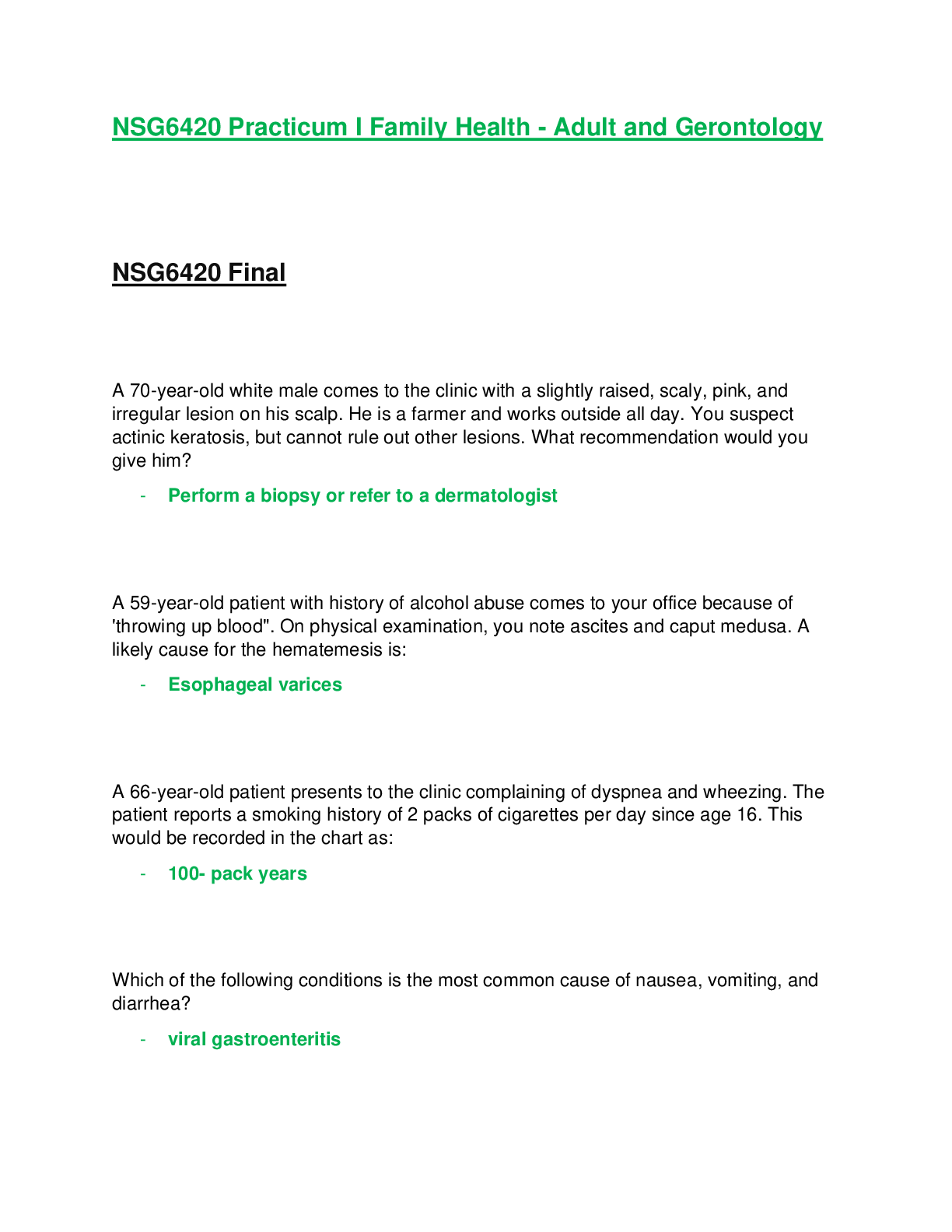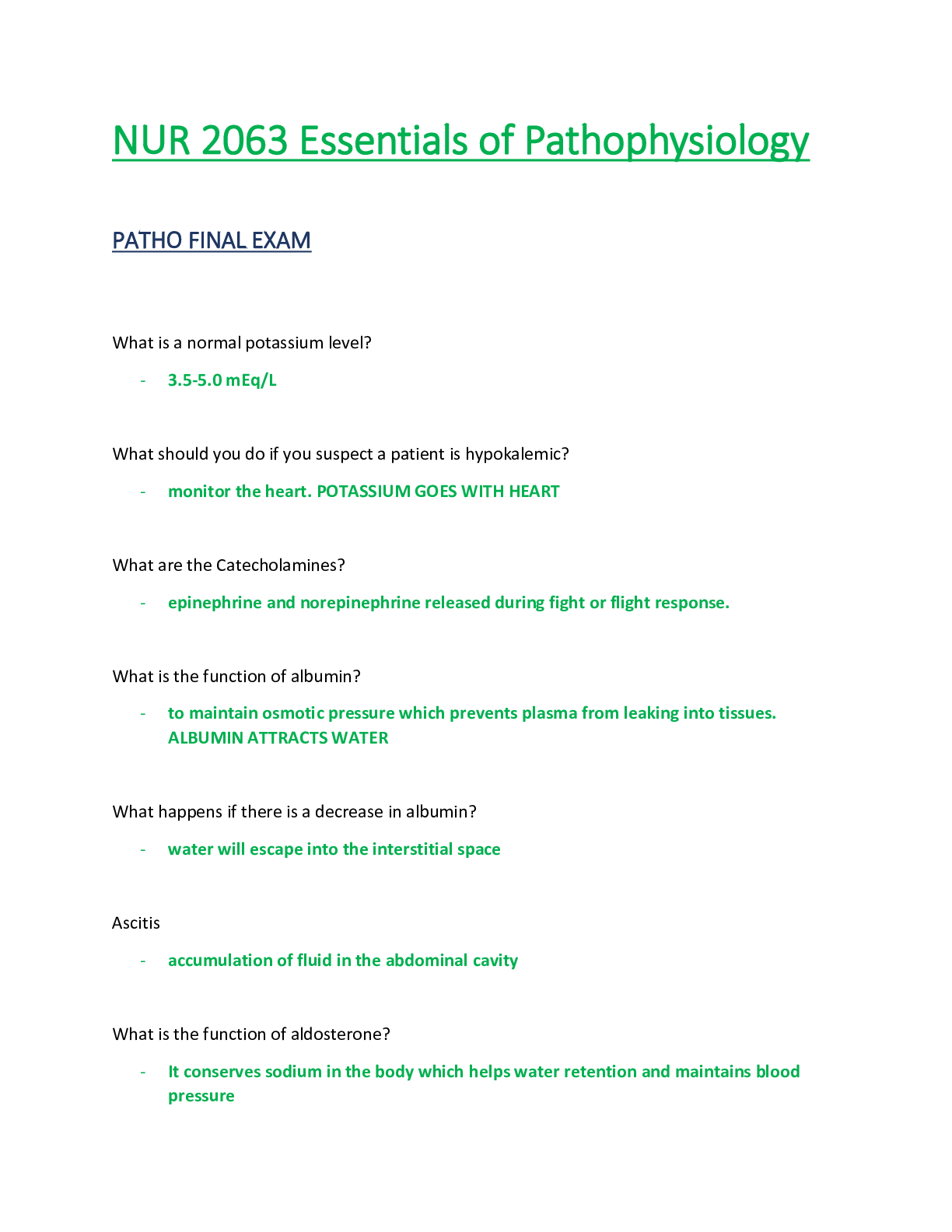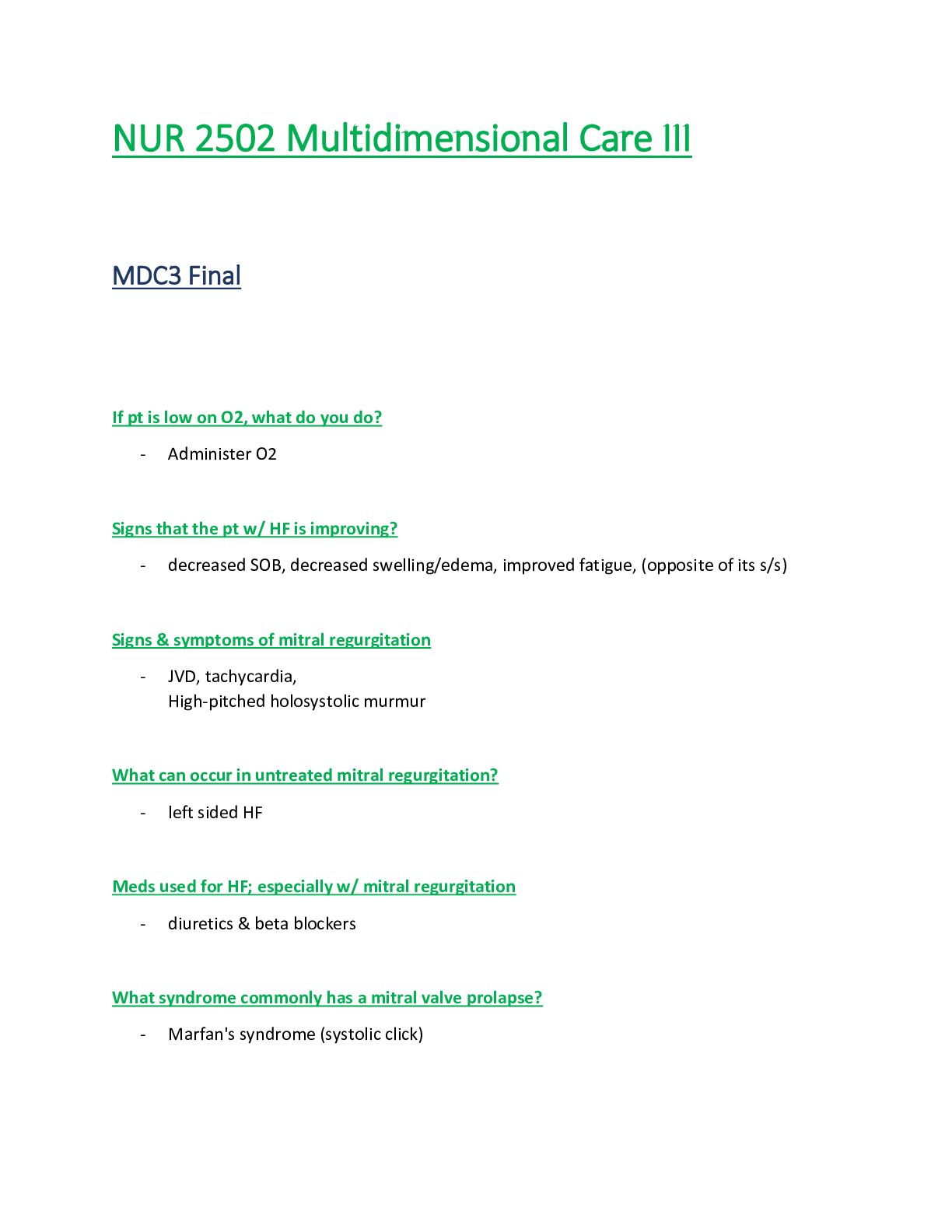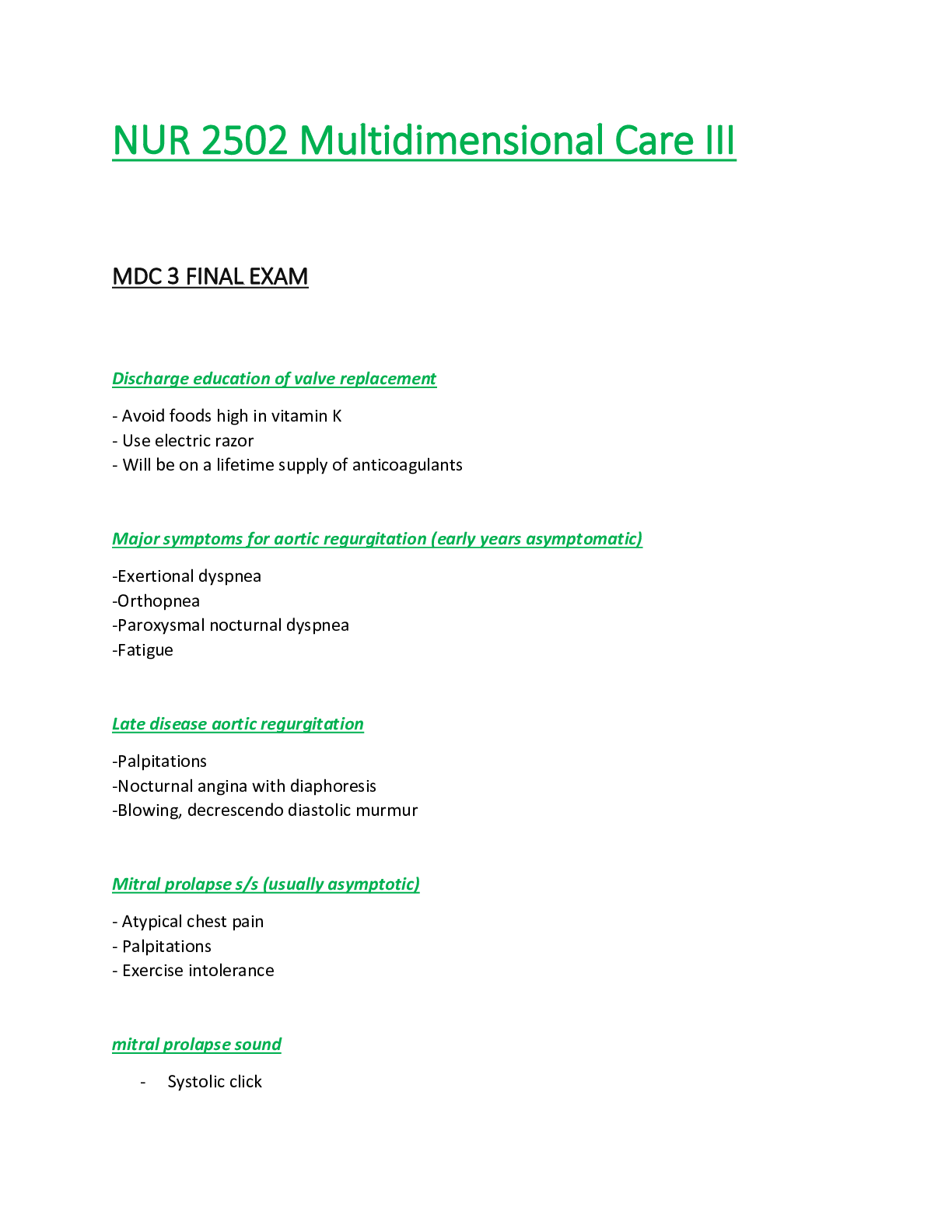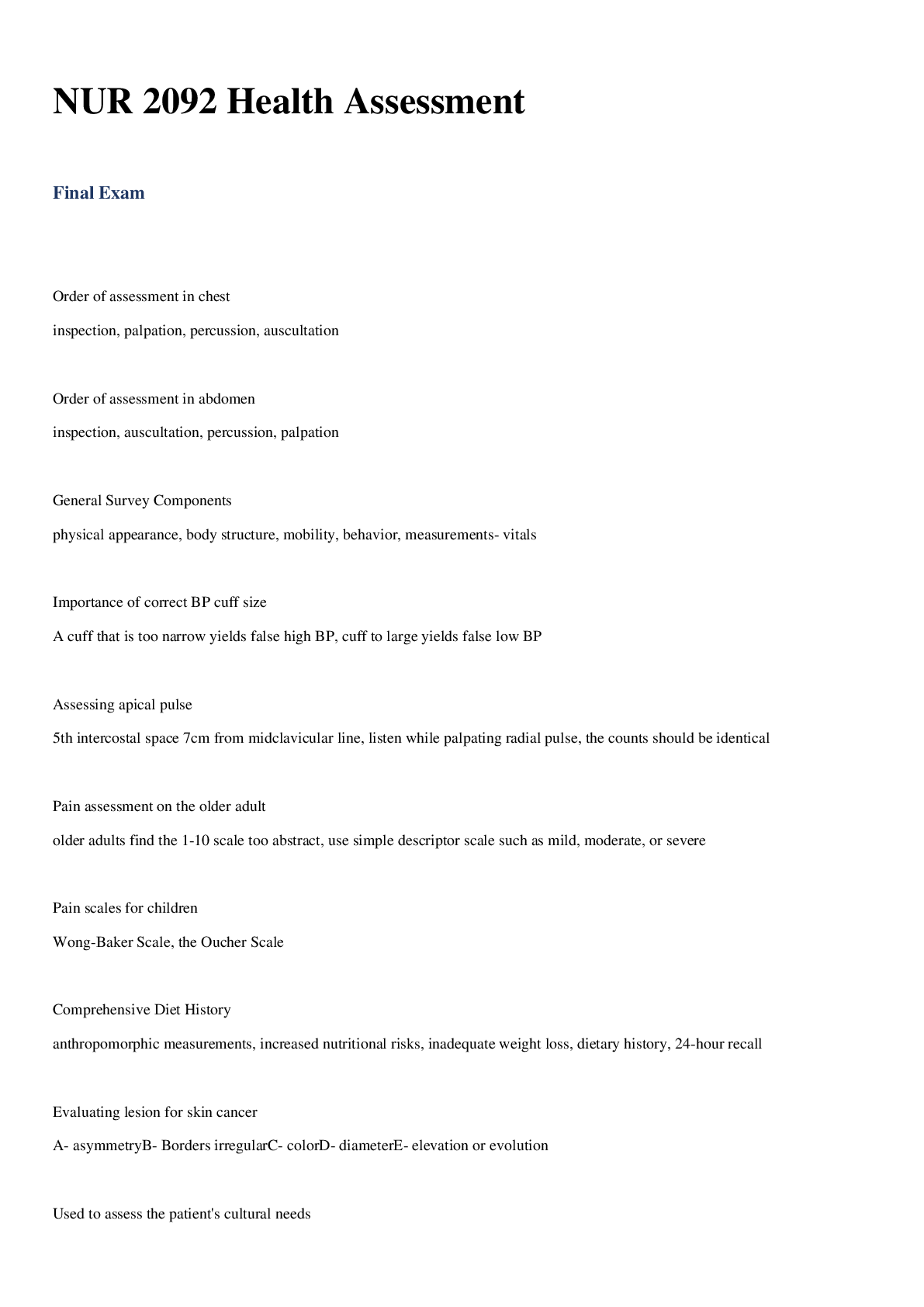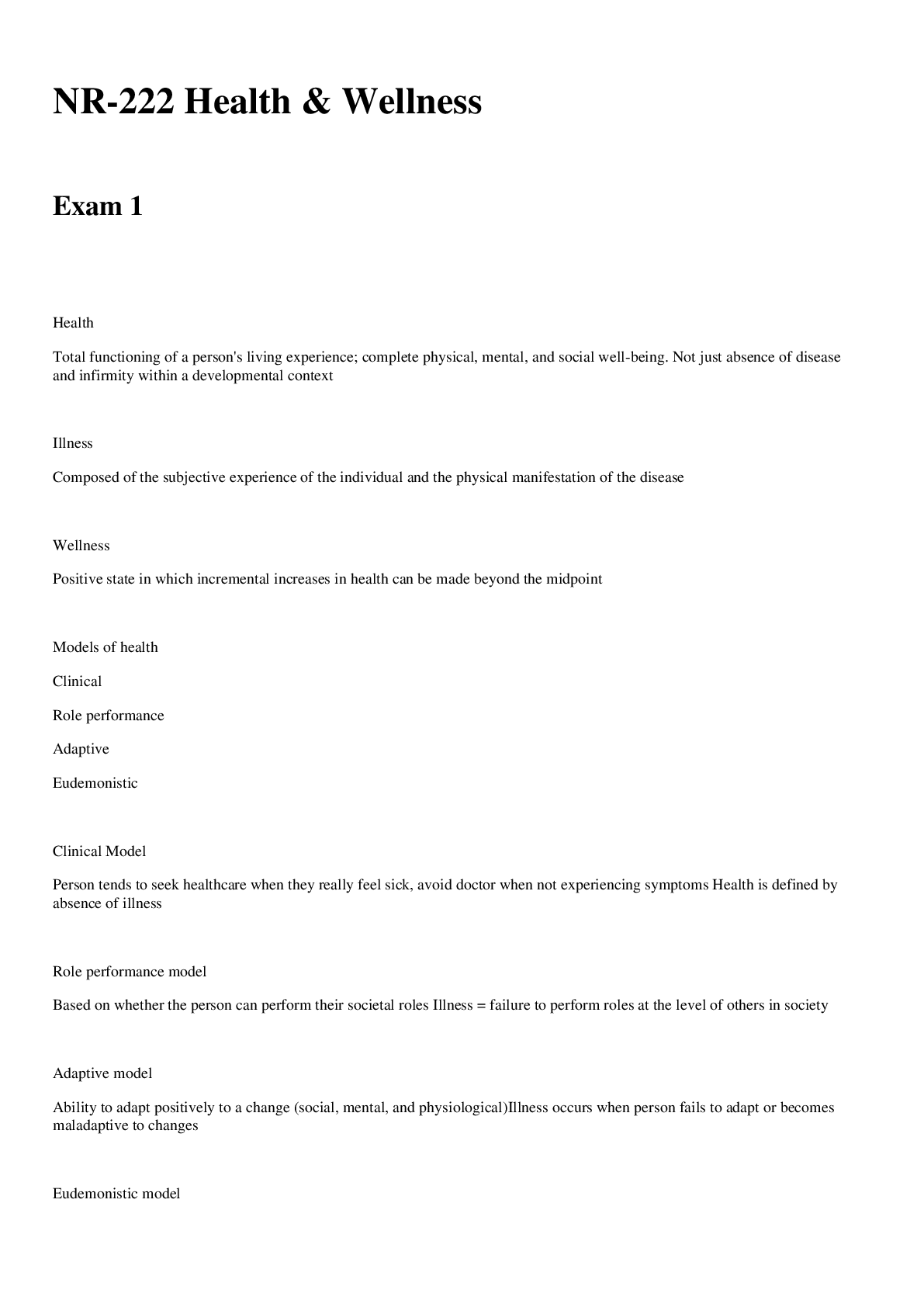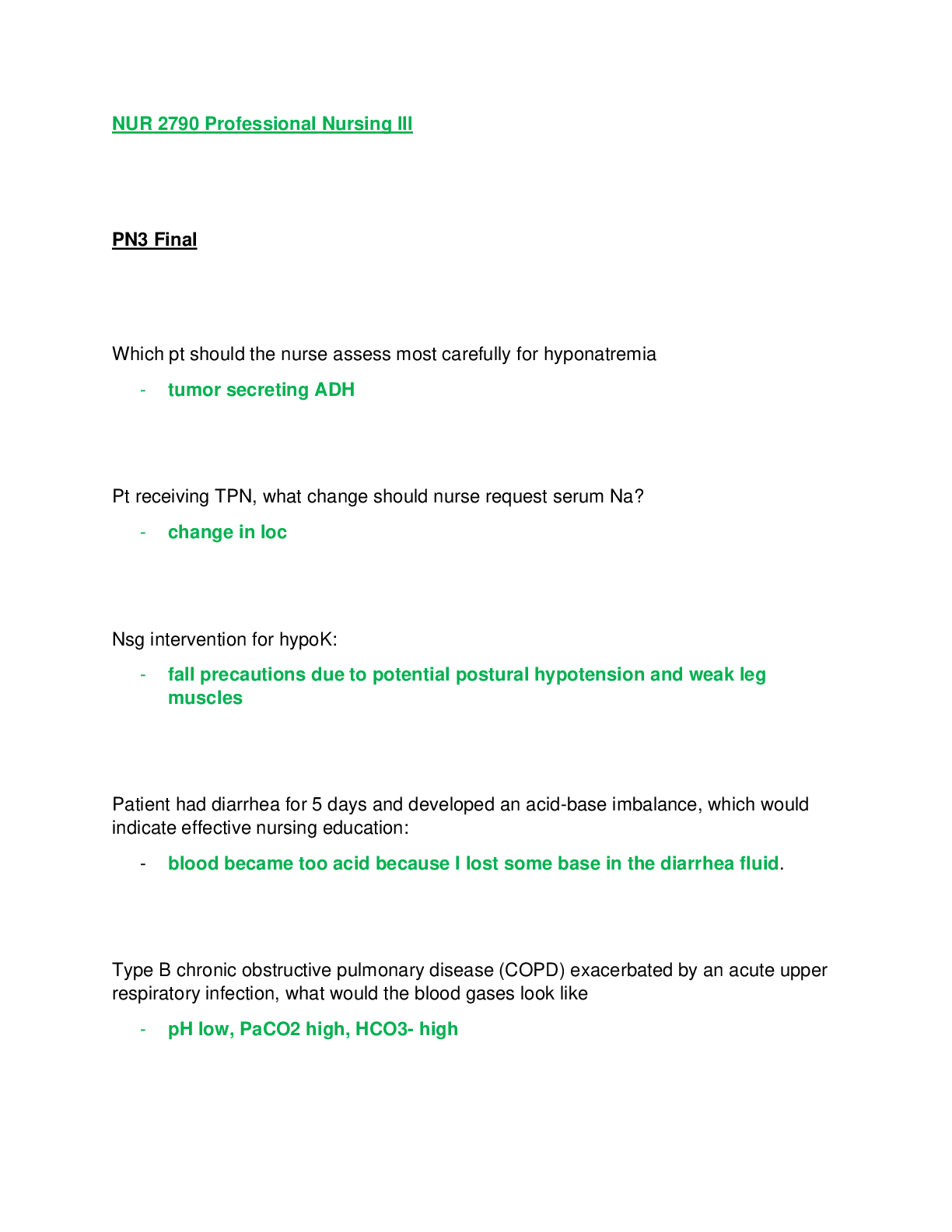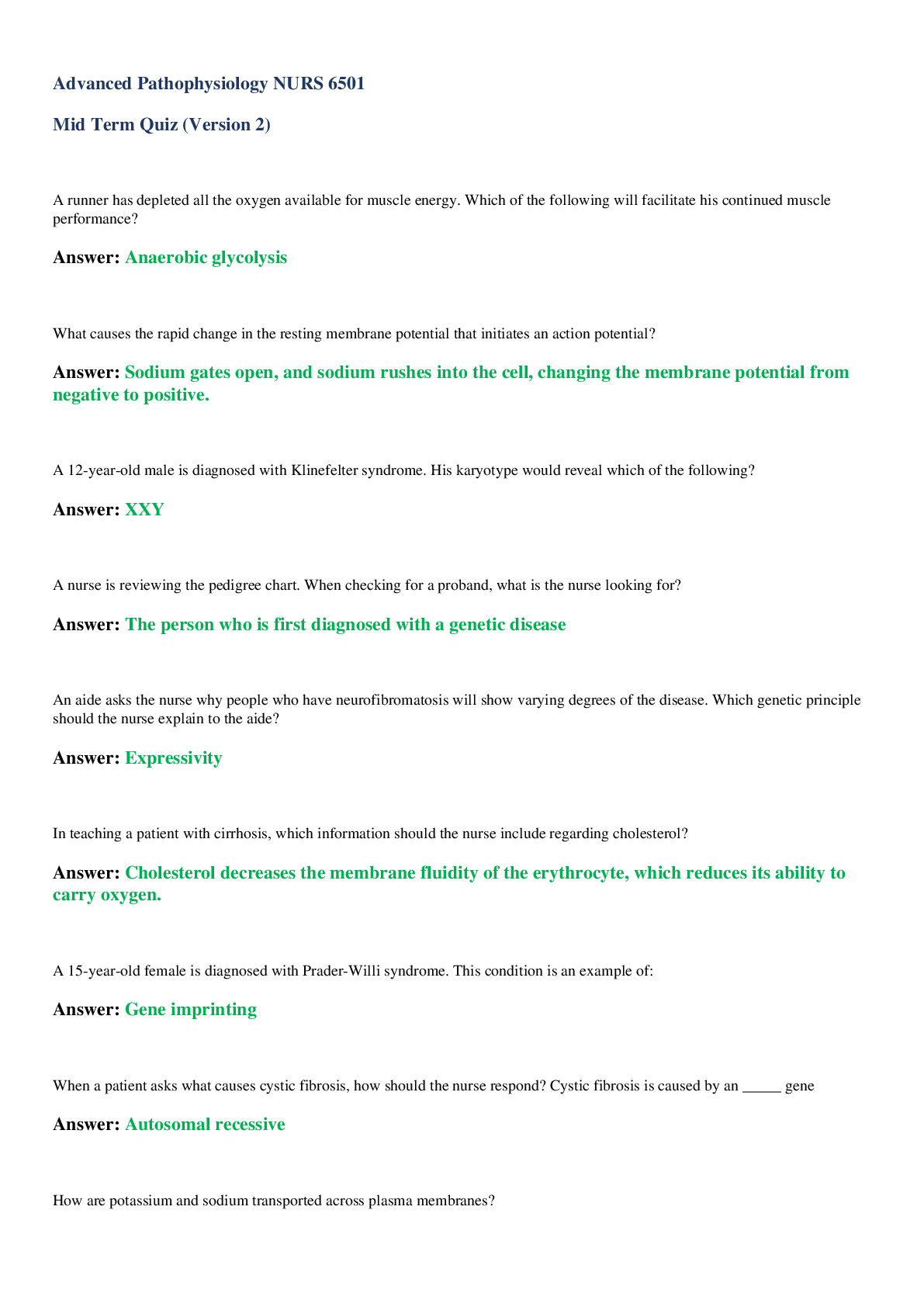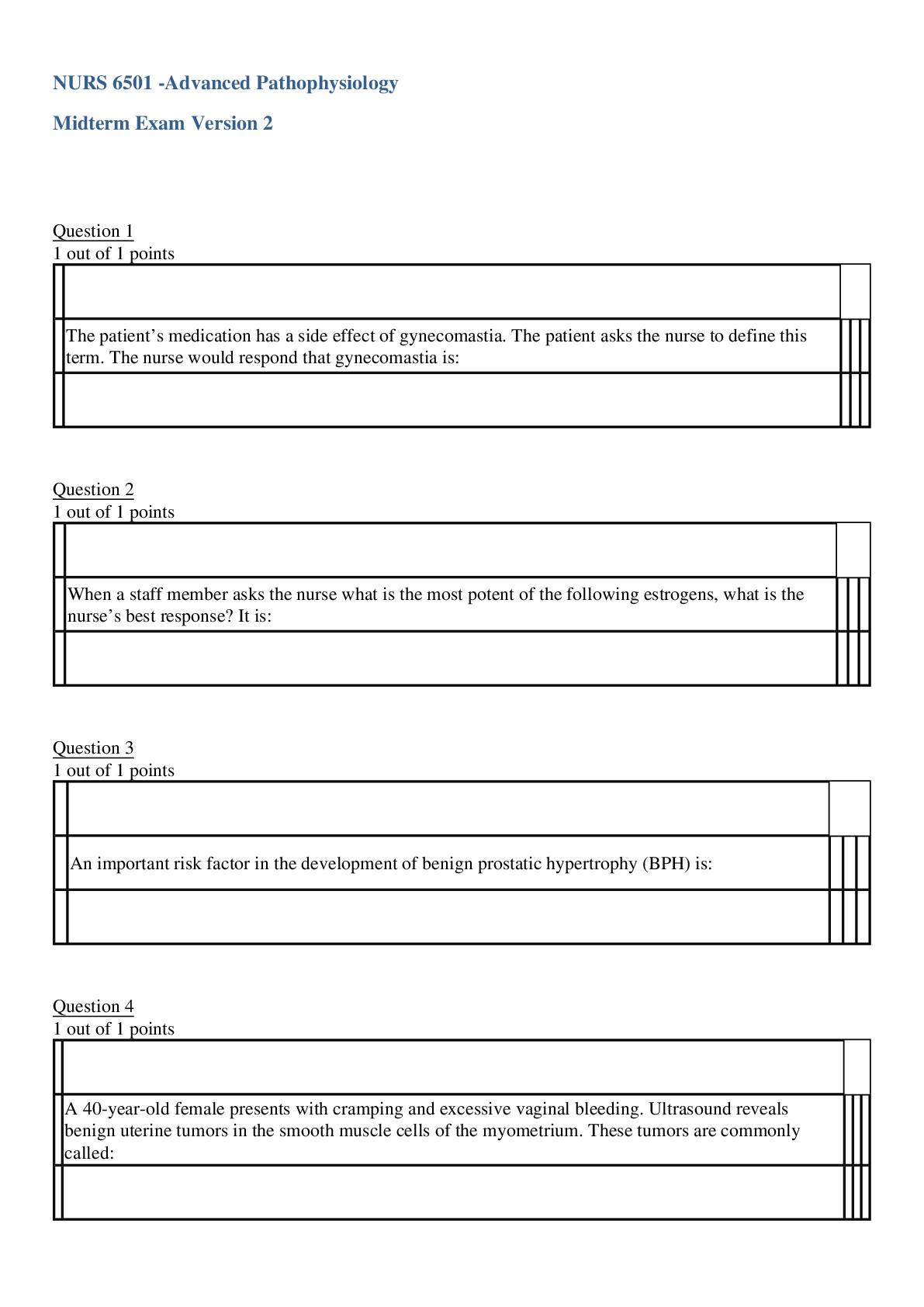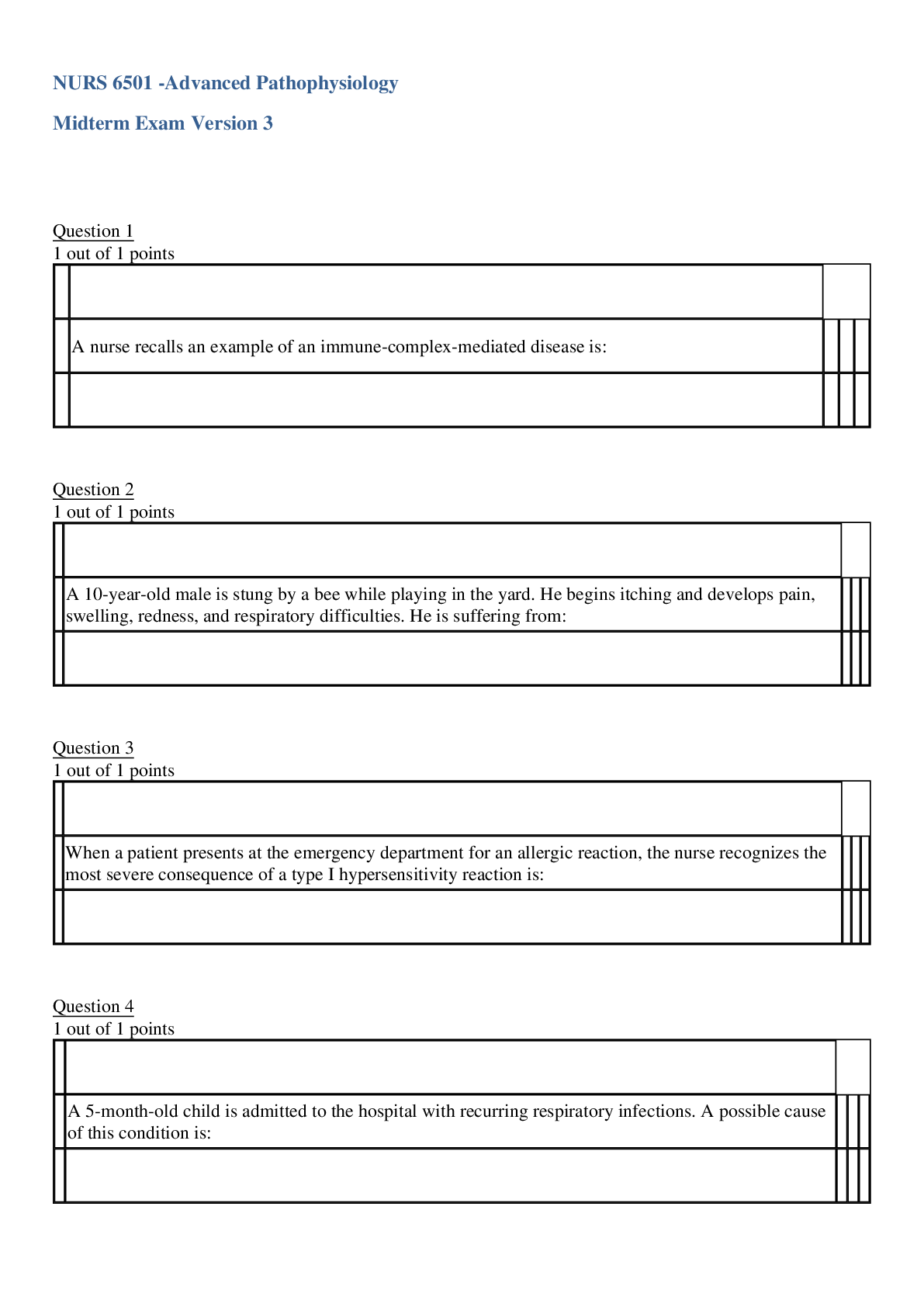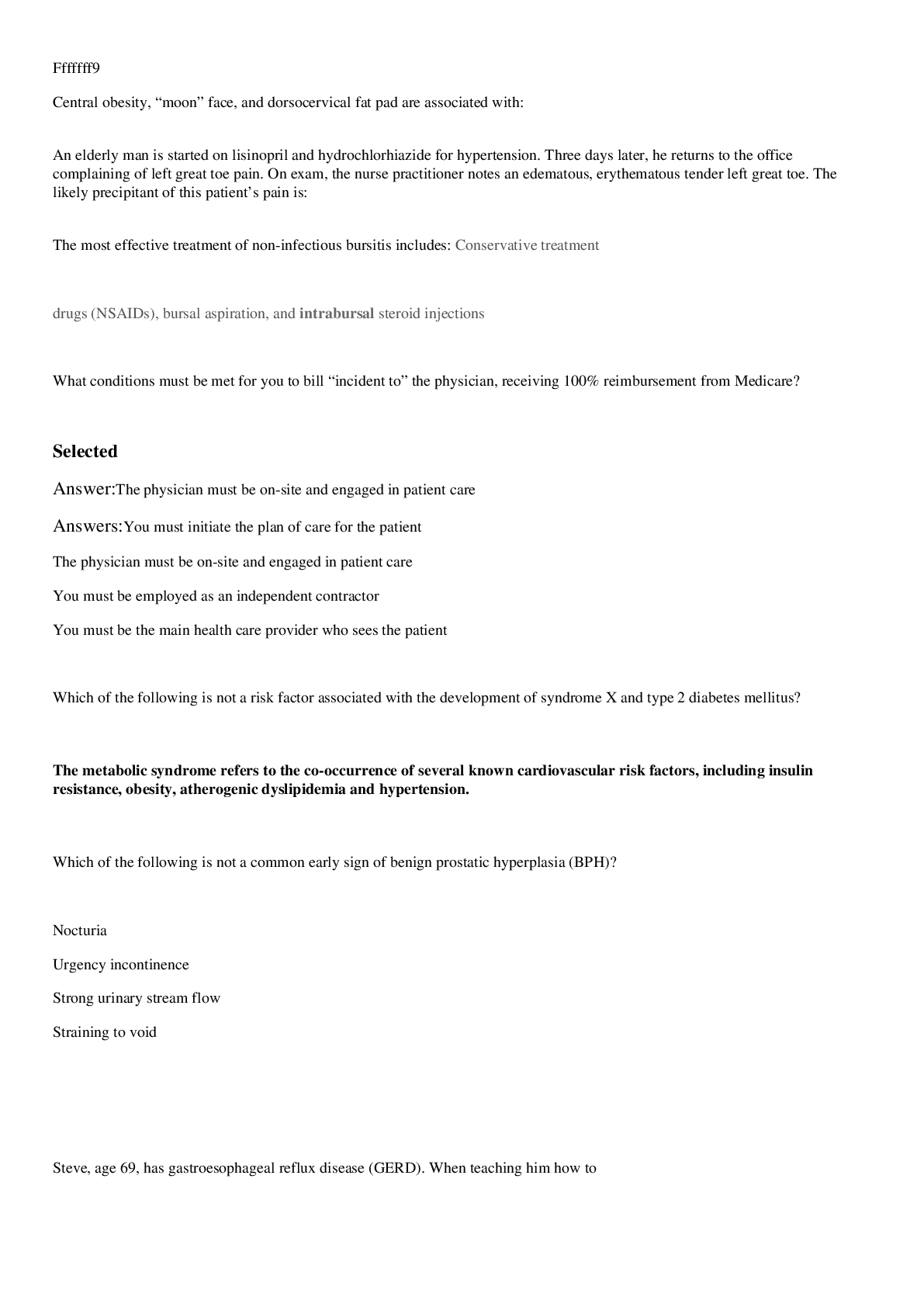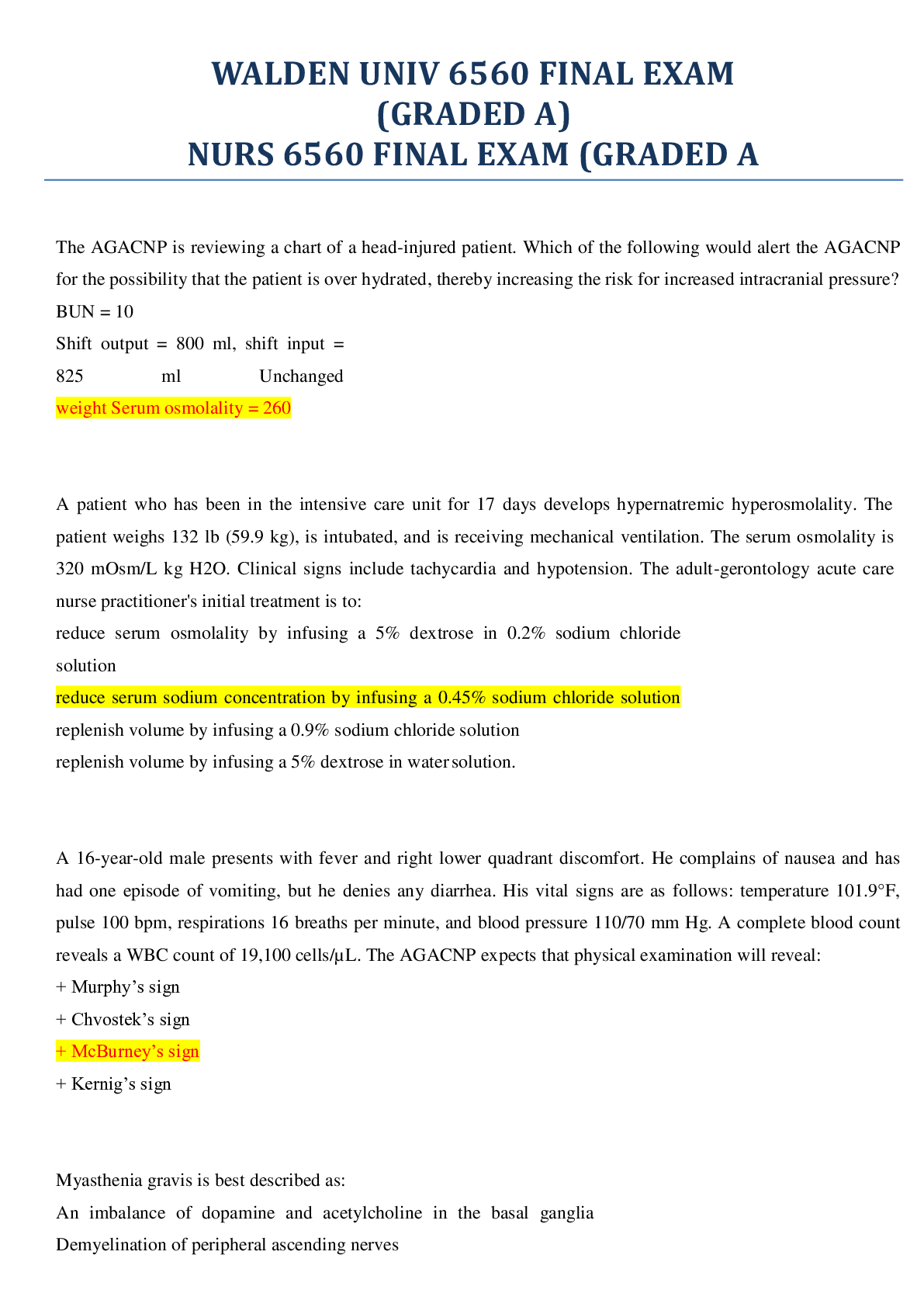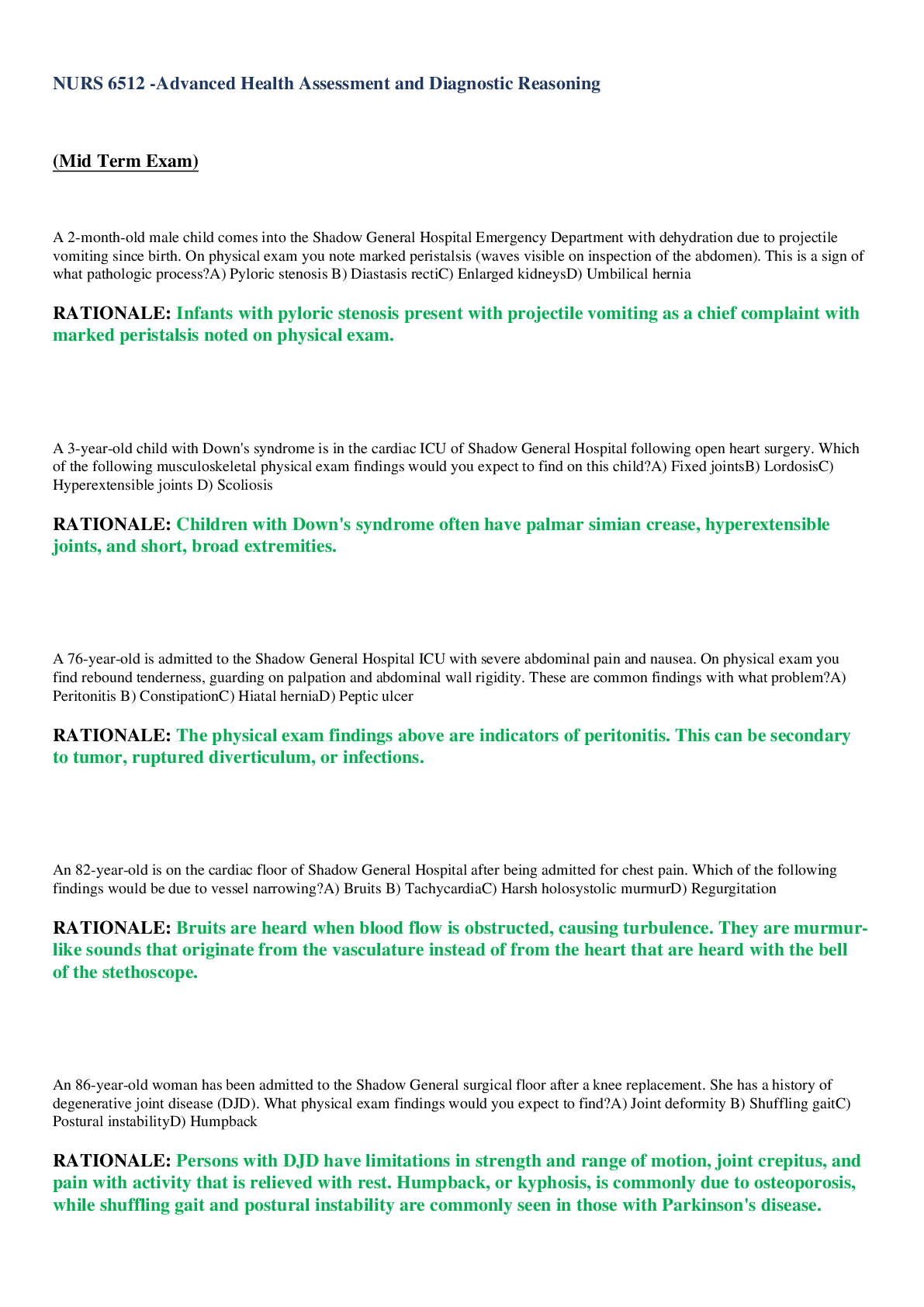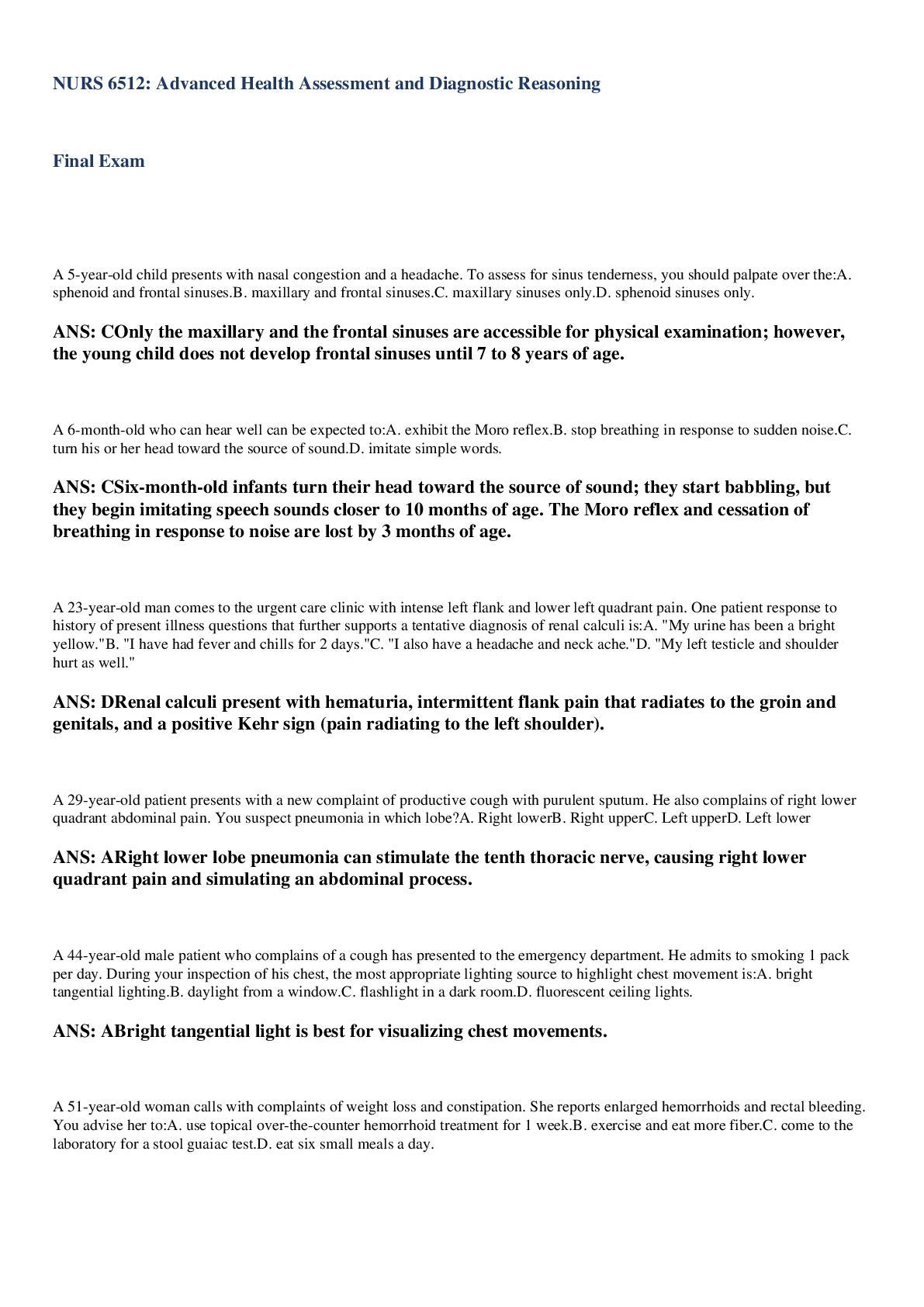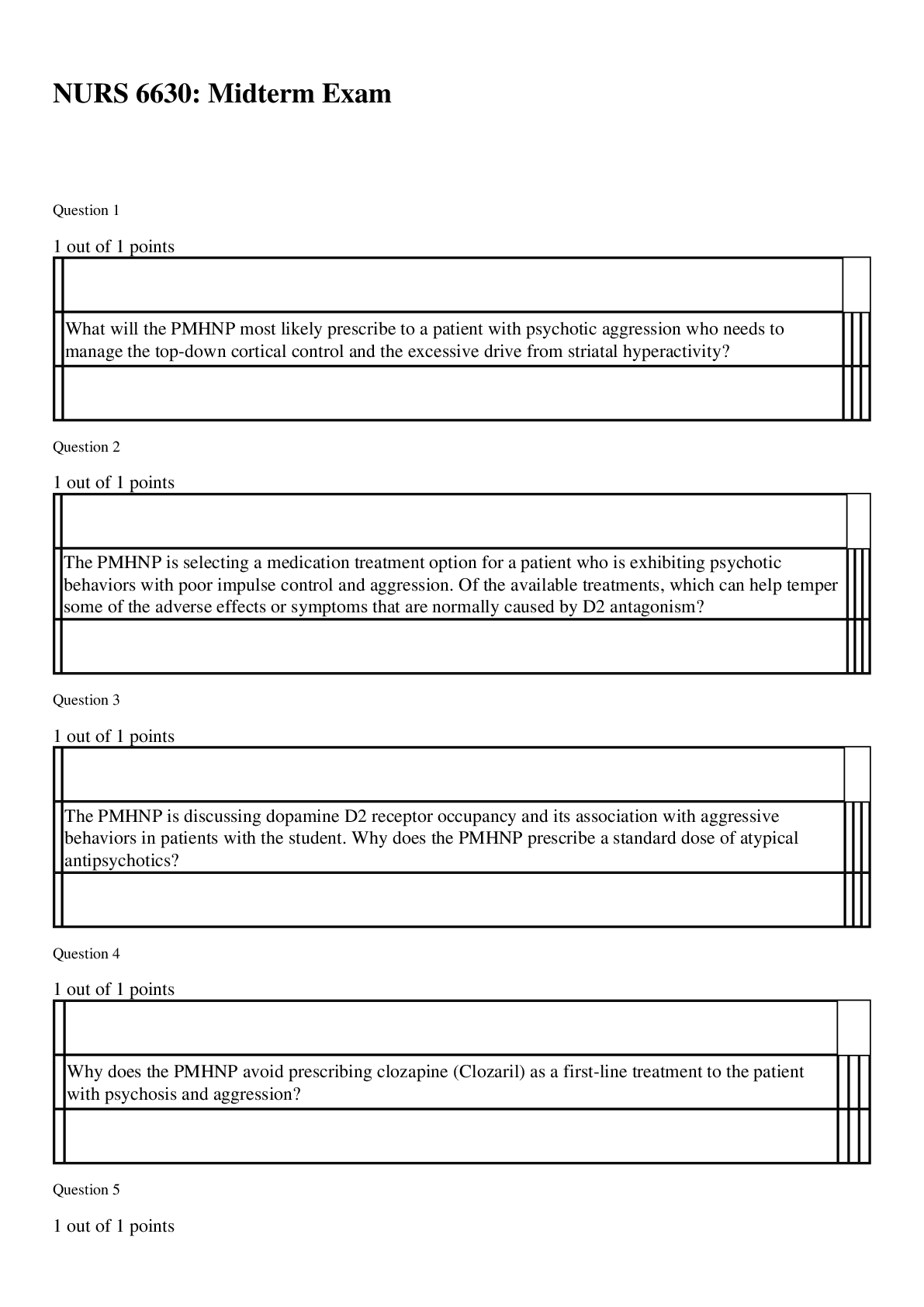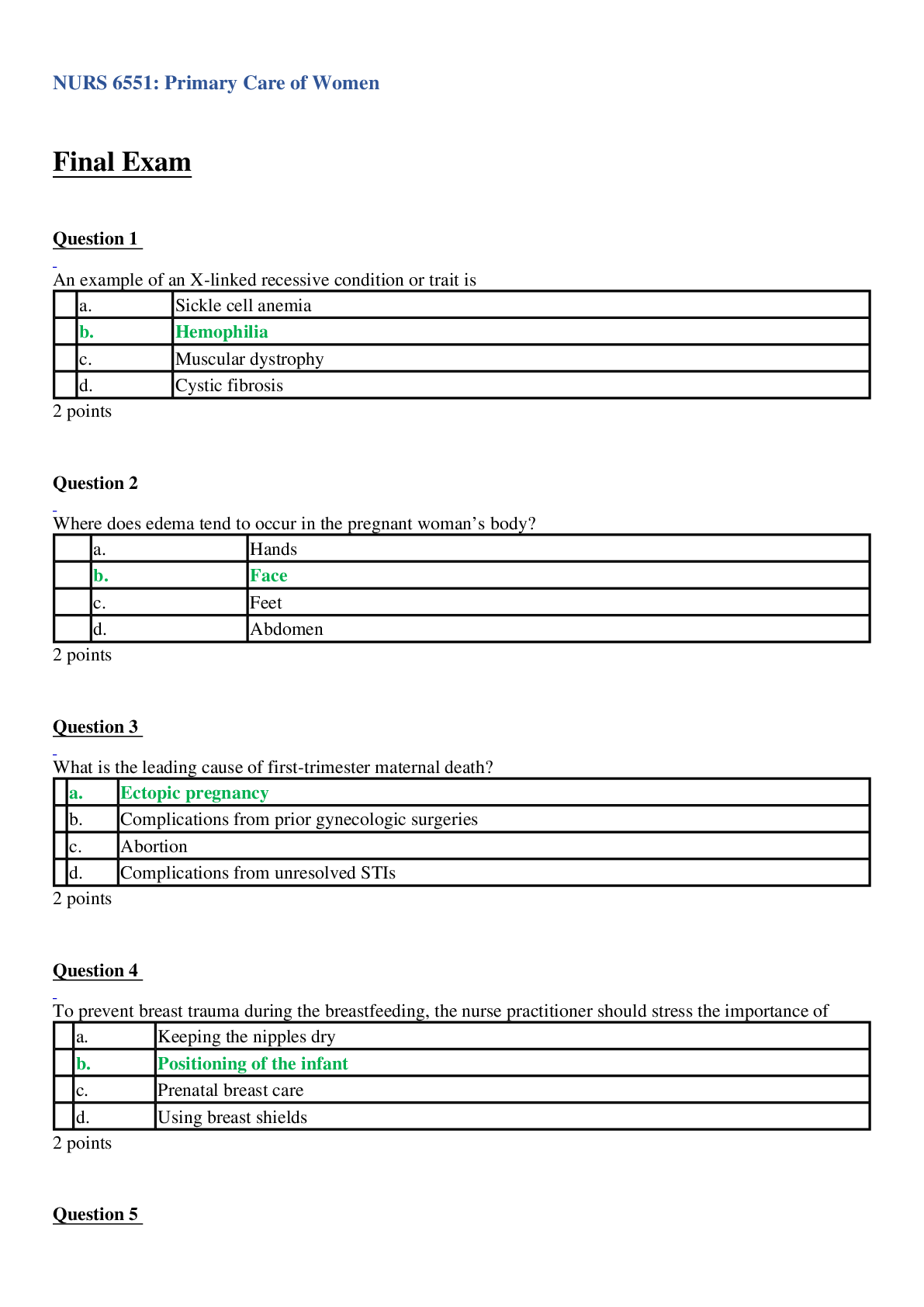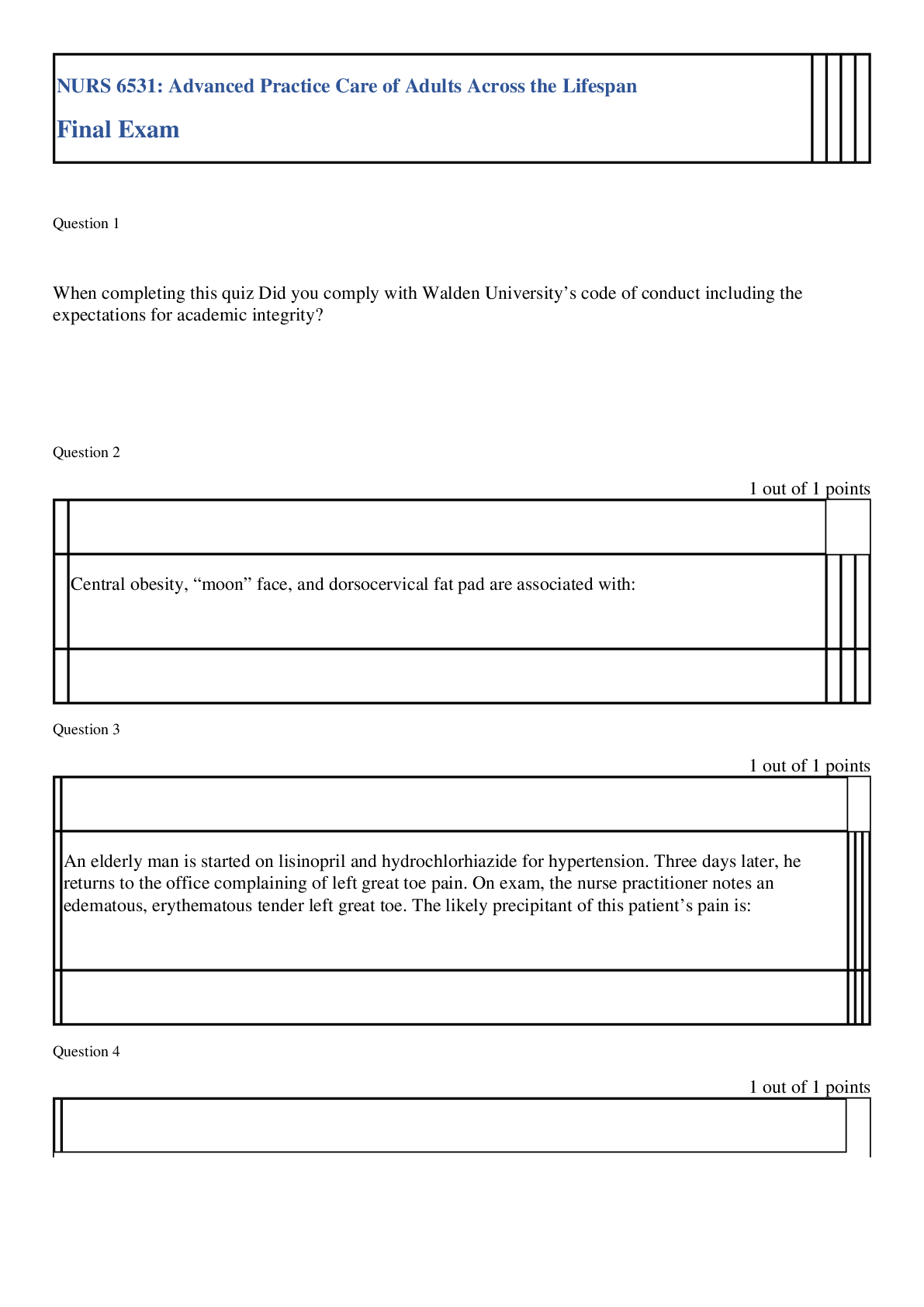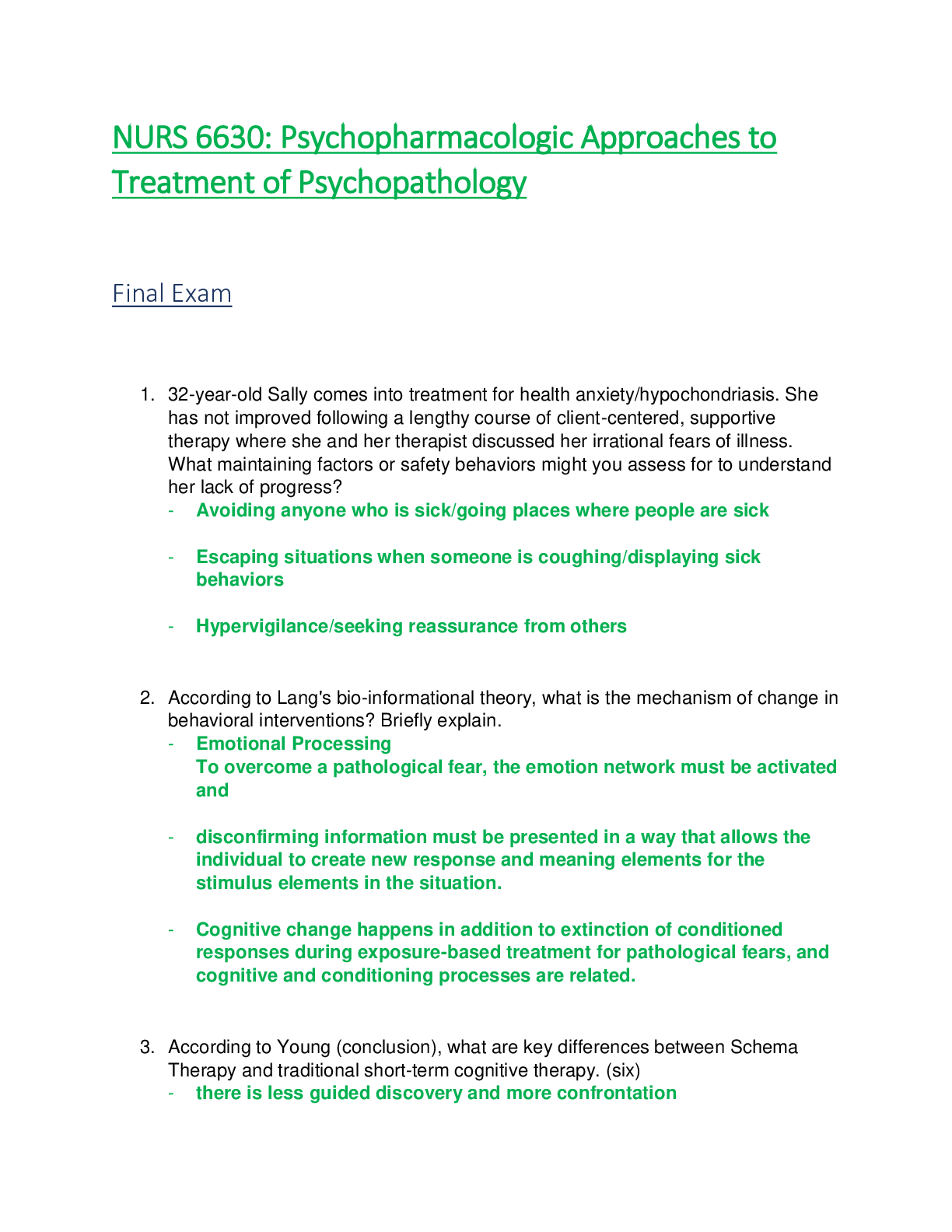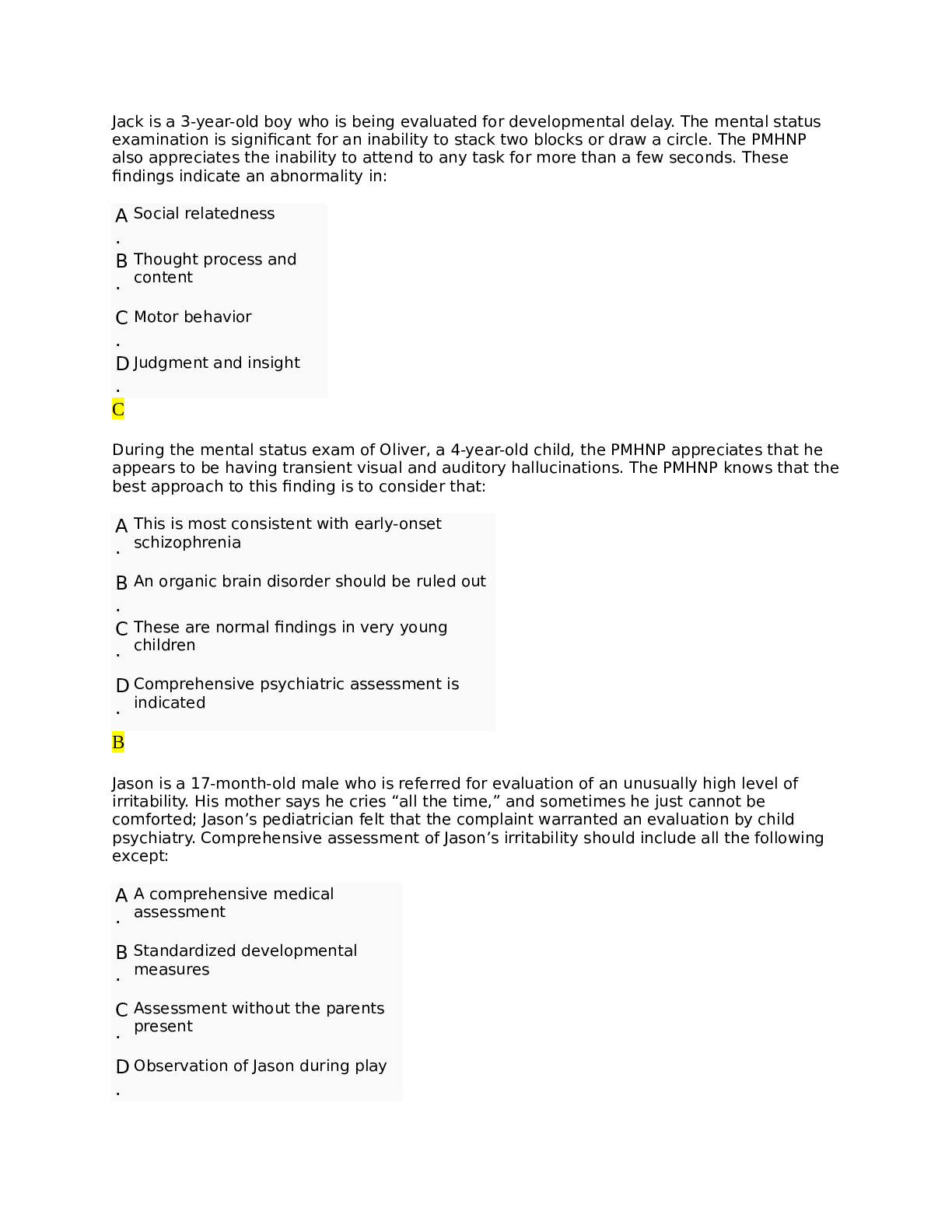*NURSING > EXAM > NURS 6531 / NURS6531: Advanced Practice Care of Adults Across the Lifespan Midterm Exam Latest Updat (All)
NURS 6531 / NURS6531: Advanced Practice Care of Adults Across the Lifespan Midterm Exam Latest Update Walden University
Document Content and Description Below
NURS 6531: Advanced Practice Care of Adults Across the Lifespan Mid Term Exam 1. An 18-year-old college freshman is brought to the student health center with a chief complaint of a 3-day history... of progressive headache and intermittent fever. On physical examination he has a positive Kernig and Brudzinski sign. The most likely diagnosis is: a. viral encephalitis b. bacterial meningitis c. acute subarachnoid hemorrhage d. epidural hematoma 2. A 24-year-old man presents with sudden onset of left-sided scrotal pain. He reports having intermittent unilateral testicular pain in the past but not as severe as this current episode. Confirmation of testicular torsion would include all of the following findings except: A. unilateral loss of the cremasteric reflex. B. the affected testicle held higher in the scrotum. C. testicular swelling. D. relief of pain with scrotal elevation. 3. A 35-year-old sexually active man presents with a 1-week history of fever and pain over the left scrotum. It is accompanied by frequency and dysuria. The scrotum is edematous and tender to touch. He denies flank pain, nausea, and vomiting. He reports that the pain is lessened when he uses scrotal-support briefs. The urinalysis shows 2 + blood and a large number of leukocytes. What is the most likely diagnosis? A. Acute urinary tract infection B. Acute pyelonephritis C. Acute orthitis D. Acute epididymitis 4. A 45-year-old woman in complaining of generalized stiffness, especially in both her wrist and hands. It is much worse in the morning and last a few hours. She also complains of fatigue and generalized body aches that have been present for the past few months. Which of the following is most likely? a. Osteoporosis b. Rheumatoid arthritis c. Osteoarthritis d. Gout 5. A 46-year-old woman complains of fatigue, weakness, lethargy, decreased concentration and memory, and increased facial hair over the past 12 months. She also reports gaining over 30 pounds (13.6 kg) in the past 2 months. She has a history of asthma with repeated flares during the past 6 months requiring multiple courses of prednisone therapy. A likely diagnosis for this patient is: A. type 2 diabetes. B. Cushing's syndrome. C. Cushing's disease. D. central obesity. 6. A 48-year old obese female presents to the clinic with complain of pain on the bottom of her feet with the first few steps in the morning that gets worse with prolonged walking. You would suspect: A. Gout B. Morton's Neuroma C. Rheumatoid Arthritis D. Plantar fasciitis 7. A 51-year-old factory worker has noticed progressive weakness over the past year. Examination and testing reveal a painless largely motor peripheral neuropathy. Of the following agents, the one most likely to be etiologic in this case is a. Lead b. Manganese c. Thallium d. Cyanide e. Mercury 8. A 54-year-old white man with no obvious risk for prostate cancer opted to undergo PSA screening and DRE testing. The DRE findings are normal and his PSA is 3..7ng/ml. You recommend: A. Repeating the PSA test immediately. B. Repeat screening in 1 yr. C. Repeat screening in 2 yrs. D. Repeat screening in 5 yrs. 9. A 56-year-old man complains of several episodes of severe lacerating pain that shoots up to his right cheek and is precipitated by drinking cold drinks or chewing. These episodes start suddenly and end spontaneously after a few seconds with several episodes per day. He denies any trauma, facial weakness, or difficulty swallowing. He has stopped drinking cold drinks because of the pain. Which of the following is most likely? A. Trigeminal neuralgia B. Cluster headache C. Acute sinusitis D. Sinus headache 10. A 63-year-old man presents to you with hematuria, hesitancy, and dribbling. DRE reveals a moderately enlarged prostate that is smooth. The client's PSA is 1.2. What is the most appropriate management strategy for you to follow at this time? ANSWER: 11. A 64-year-old woman presents to your clinic with a sudden right-sided headache that is worse in her right eye. She claims her vision seems blurred, and her right pupil is dilated and slow to react. The right conjunctiva is markedly injected, and the eyeball is firm. You screen her vision and find that she is 20/30 OS and 20/30 OD. She most likely has A. open-angle glaucoma. B. angle-closure glaucoma. C. herpetic conjunctivitis. D. diabetic retinopathy. 12. A 65-year-old carpenter complains of stiffness and pain in both hands and right knee shortly after waking and worsens in the afternoon. He feels some relief with rest. On, exam the nurse practitioner notices the presence of Heberden's nodes. Which of the following is most likely? a. Osteoporosis b. Rheumatoid Arthritis c. Osteoarthritis d. Reiter's syndrome 13. An 81-year-old man who was recently diagnosed with Alzheimer's-type dementia is accompanied by his granddaughter for an office visit. The granddaughter reports that her grandfather often acts erratically with angry outbursts that can soon be followed by a more "normal" demeanor. She reports that the grandfather recently moved in with her, and she would like for this arrangement to continue as long as possible. In counseling the granddaughter, you consider all of the following except that: A. behavioral difficulties often arise in patients with AD if their usual routine is disrupted. B. treatment with a cholinesterase inhibitor will likely improve his mental status to a point similar to his pre-dementia baseline. C. a home safety evaluation should be conducted, and appropriate modification performed. D. any sudden change in mental status should be reported to the healthcare provider as soon as possible. 14. According to recent epidemiologic studies, prostate cancer is the number ____ cause of cancer death in men residing within the US. (B) A. 1 B. 2 C. 3 D. 4 15. According to the AUA guideline on the management of BPH, when is referral for invasive surgery automatically warranted? 16. The action of a 5 alpha-reductase inhibitor in the treatment of BPH is to: reduce action of androgens in the prostate. 17. Acute cerebral hemorrhage is best identified with which of the following imaging techniques? a. transesophageal echocardiogram b. CT Scan c. Cerebral angiogram d. MR angiography 18. An adult woman comes to the clinic presenting with gradual onset of throbbing headaches behind one eye worsening over several eyes is diagnosed as a. Cluster headache b. Migraine headache c. Trigeminal neuralgia d. Temporal arteritis 19. Alexander, age 18, sprained his ankle playing ice hockey. He is confused as to whether to apply heat or cold. What do you tell him? A. " Use continuous heat for the first 12 hours, then use heat or cold to your own preference. " B. " Use continuous cold for the first 12 hours, then use heat or cold to your own preference. " C. " Apply cold for 20 minutes, then take it off for 30 - 45 minutes; repeat for the first 24 - 48 hours while awake. " D. " Alternate between cold and heat for 20 minutes each for the first 24 - 48 hours. " 20. All of the following are possible etiologies for papilledema a. Intracranial abscess b. Ruptured aneurysm c. Migraine headaches d. Cerebral edema 21. All of the following can cause a elevated PSA level except: A. current prostate infection B. recent cystoscopy C. BPH D. prostatectomy 22. All of the following can cause an elevated PSA level except: A. Current prostate infection B. Recent cystoscopy C. BPH D. Prostatectomy 23. Anticipated organ survival exceeds 85% with testicular decompression within how many hours of torsion? A. 1 B. 6 C. 16 D. 24 24. The average American man has an approximately ____% lifetime risk of prostate cancer and an approximately ____% likelihood of clinical disease. A. 15, 5 B. 25, 8 C. 40, 10 D. 60, 15 25. Balanitis is a symptom of which one of the following diseases A. Psoriatic arthritis B. Reactive arthritis C. Ankylosing Spondylitis D. Rheumatoid arthritis 26. Balanitis is caused by: A. Staphylococcus aureus B. Streptococcus pyogenes C. Candida albicans D. Trichomonads 27. The best screening test for detecting hyperthyroidism and hypothyroidism is: 28. Beth, age 49, comes in with low back pain. An x-ray of the lumbar/sacral spine is within normal limits. Which of the following diagnoses do you explore further? A. Scoliosis B. Osteoarthritis C. Spinal stenosis D. Herniated nucleus pulposus 29. Bouchard's nodule is found in which of the following? A) Rheumatoid arthritis B) Degenerative joint disease C) Psoriatic arthritis D) Septic arthritis 30. Carpal tunnel syndrome is inflammation of the: A) Ulnar nerve B) Radial nerve C) Brachial nerve D) Median nerve 31. The cause of multiple sclerosis is best described as: a. A destructive process of the never fiber protecting myelin b. An intracranial viral infection c. Inflammation of the brain and/or spinal cord d. An autoimmune disorder that destroys muscle fibers 32. A client had excessive blood loss and prolonged hypotension during surgery. His postoperative urine output is sharply decreased, and his blood urea nitrogen (BUN) is elevated. The most likely cause for the change is acute: A) Prerenal inflammation B) Bladder outlet obstruction C) Tubular necrosis D) Intrarenal nephrotoxicity 33. Clinical conditions with a presentation similar to acute bursitis include which of the following? (More than one can apply.) A. rheumatoid arthritis B. septic arthritis C. joint trauma D. pseudogout ANSWER: all of the above 34. Common physical findings of SLE include all the following except: A. weight gain. B. joint pain and swelling. C. fatigue. D. facial rash. 35. Common risk factors for Osgood Schlatter Disease include: a. Highly active with open growth plates b. Significant Growth Spurt c. Typically asymmetrical but can occur bilaterally d. Boys> Girls e. All of the above ANSWER: All of the above 36. Common signs of high-grade aortic stenosis in an individual during exercise include all of the following except: A. dyspnea. B. angina. C. seizure. D. syncope. 37. Common symptoms of MS include all of the following except: a. Numbness or weakness in one or more limbs b. Double vision or blurring vision c. Facial weakness or numbness d. Cold sensitivity 38. Cushing's disease is the specific type of Cushing's syndrome that is caused by: A. long-term exposure to corticosteroids. B. a benign tumor of the adrenal gland. C. a benign pituitary tumor. D.an ectopic tumor that produces ACTH. 39. Cushing's syndrome results from an excess of: A. luteinizing hormone. B. follicle-stimulating hormone. C. cortisol. D. aldosterone. 40. Dan, age 49, developed osteomyelitis of the femur after a motorcycle accident. Which of the following statements about the clinical manifestations of osteomyelitis is correct? A. Integumentary effects include swelling, erythema, and warmth at the involved site. B. There is a low-grade fever with intermittent chills C. Musculoskeletal effects include tenderness of the entire leg. D. Cardiovascular effects include bradycardia. 41. Dave, age 76, is brought in by his wife, who states that within the past 2 days Dave has become agitated and restless, has had few lucid moments, slept very poorly last night, and can remember only recent events. Of the following differential diagnoses, which seems the most logical from this brief history? a. Depression b. Dementia c. Delirium d. Schizophrenia 42. The diagnosis of Parkinson disease relies on findings of: a. Clinical evaluation of six cardinal features b. Head MRI or CT scan c. Pleocytosis in the CSF d. A visual evoked potential test 43. ______ Disorder in Cushing's is due to excessive ACTH production and ACTH dependent 44. Dopamine or dopamine agonists used to treat Parkinson disease include all of the following except: a. Levodopa b. Chlorpromazine c. Ropinirole d. Pramipexole 45. Fibromyalgia is more common in patients with: A. type 2 diabetes. B. rheumatoid arthritis and systemic lupus erythematosus. C. migraine headaches. D. chronic obstructive pulmonary disorder (COPD). 46. A first-line approach to treating Cushing's syndrome in a 56-year-old woman who has been taking oral corticosteroids to treat rheumatoid arthritis for the past 2 years is: A. gradually tapering corticosteroid use. B. referral for surgery. C. consideration of radiation therapy. D. prescribing mifepristone. 47. A first-line approach to treating Cushing's syndrome in a 56-year-old woman who has been taking oral corticosteroids to treat rheumatoid arthritis for the past 2 years is: A. gradually tapering corticosteroid use. B. referral for surgery. C. consideration of radiation therapy. D. prescribing mifepristone. 48. A first-line prophylactic treatment option for the prevention of tension-type headache is a. Nortriptyline b. Verapamil c. Carbamazepine d. valproate 49. First-line therapy for prepatellar bursitis should include: A. bursal aspiration. B. intrabursal corticosteroid injection. C. acetaminophen. D. knee splinting. 50. First-line treatment of SLE in a patient with mild symptoms is: A. systemic corticosteroids. B. hydroxychloroquine plus NSAIDs. C. anakinra. D. methotrexate. 51. First-line treatment options for bursitis usually include: A. corticosteroid bursal injection. B. heat to area. C. weight-bearing exercises. D. nonsteroidal anti-inflammatory drugs (NSAIDs). 52. The following are causes of scoliosis except: a. unknown b. spinal congenital deformity c. arthritis d. herniated disc. 53. The following measures are used for treating various types of headache. Which is not considered to be effective therapy for migraine? a. Propanolol prophylaxis b. Resting in a quiet and darkened room c. Trimethobenzamide suppositories for nausea d. Sodium restriction to decrease water retention 54. Gerard is complaining of a scrotal mass; however, the scrotum is so edematous that it is difficult to assess. How do you determine if it is a hernia or a hydrocele? ANSWER: 55. Ginny, age 48, has rheumatoid arthritis and gets achy and stiff after sitting through a long movie. This is referred to as A. longevity stiffness B. gelling C. intermittent arthritis D. molding 56. The Hallpike maneuver is performed to elicit A. a seizure. B. vertigo. C. syncope. D. a headache. 57. Harry has BPH and complains of some incontinence. Your first step in diagnosing overflow incontinence would be to order a: ANSWER: P 58. Heidi, age 29, is a nurse who has an acute episode of back pain. You have determined that it is a simple "mechanical" backache and order A) Bedrest for 2 days B) Muscle relaxants C) "Let pain be your guide" and continue activities D) Back-strengthening exercises 59. A history of urinary tract infections in males is often seen in men with chronic bacterial prostatitis. Other signs and symptoms of chronic bacterial prostatitis includes A. irritative voiding symptoms, low back pain, and perineal pain. B. nausea and vomiting, as well as fever. C. loss of appetite and weight loss. D. irritative voiding symptoms, inability to ambulate, and fever. 60. If any limitation or any increase in range of motion occurs when assessing the musculoskeletal system, the angles of the bones should be measured by using A. Phalen ' s test. B. skeletometry. C. the Thomas test. D. a goniometer. 61. Immediate diagnostic imaging for low back pain should be reserved for all of the following EXCEPT: A. presence of signs of the cauda equina syndrome. B. presence of severe neurological deficits. C. presence of risk factors for cancer. D. presence of moderate pain lasting at least 2 weeks. 62. In assessing a man with testicular torsion, the NP is most likely to note: A. elevated PSA level. B. white blood cells reported in urinalysis. C. left testicle most often affected. D. increased testicular blood flow by color-flow Doppler ultrasound. 63. In assessing the skeletal muscles, you turn the forearm so that the palm is up. This is called A. supination. B. pronation. C. abduction. D. eversion. 64. Initial treatment of lateral epicondylitis includes all of the following EXCEPT: A. rest and activity modifications B. corticosteroid injections C. topical or oral NSAIDS D. counterforce bracing brace centered over the back of the forearm can help relieve symptoms 65. In prescribing prednisone for the patient with Bell’s palsy, the NP considers that its use: A. Has not been shown to be helpful in improving outcomes in the condition. B. Should be initiated asap after the onset of facial paralysis. C. Is likely to help minimize ocular symptoms. D. May prolong the course of the disease. 66. In tension-type headache, which of the following statements is true? a. Photophobia is seldom reported. b. The pain is typically described as "pressing" in quality c. The headache is usually unilateral d. Physical activity usually makes the discomfort worse 67. It is defined as a true deformity of the spine a. functional scoliosis b. structural scoliosis c. arthritic scoliosis d. neurofibroma scoliosis 68. Janice is recovering from osteomyelitis of her leg. She asks you for advice as to what she can do to promote healing. You tell her to: A. put weight on the affected leg more frequently to promote increased circulation, oxygenation, and nutrition to the tissues of the wound area. B. eat foods high in vitamins and calcium and increase her calorie and protein intake. C. spend time in the fresh air and expose the wound to fresh air and sunlight. D. be sure to use strict aseptic technique when changing the dressing, which should be kept wet at all times to improve wound healing. 69. John, age 17, works as a stock boy at the local supermarket. He is in the office for a routine visit. You notice that he had an episode of low back pain 6 months ago from improperly lifting heavy boxes. In discussing proper body mechanics with him to prevent future injuries, you tell him, A. " Bend your knees and face the object straight on. " B. " Hold boxes away from your body at arm 's length. " C. " Bend and twist simultaneously as you lift. " D. " Keep your feet firmly together. " 70. Jonas, age 62, experienced a temporary loss of consciousness that was associated with an increased rate of respiration, tachycardia, pallor, perspiration, and coolness of the skin. How would you describe this? A. Lethargy B. Delirium C. Syncope D. A fugue state 71. Jordan appears with a rapid onset of unilateral scrotal pain radiating up to the groin and flank. You are trying to differentiate between epididymitis and testicular torsion. Which test to determine whether swelling is in the testis or the epididymis should be your first choice? A. X-ray B. Ultrasound C. Technetium scan D. Physical examination 72. Karina a client with myasthenia gravis is to receive immunosuppressive therapy. The nurse understands that this therapy is effective because it: A. Stimulates the production of acetylcholine at the neuromuscular junction. B. Promotes the removal of antibodies that impair the transmission of impulses C. Inhibits the breakdown of acetylcholine at the neuromuscular junction. D. Decreases the production of autoantibodies that attack the acetylcholine receptors. 73. The Lachman maneuver is used to detect which of the following? A. instability of the knee B. nerve damage of the knee due to past knee injuries C. integrity of the patellar tendon D. tears on the meniscus of the knee 74. Likely sequelae of intrabursal corticosteroid injection include: A. irreversible skin atrophy. B. infection. C. inflammatory reaction. D. soreness at the site of injection. 75. Lower urinary tract symptoms in males can present as a constellation of storage or voiding symptoms. Storage symptoms include: ANSWER: 76. Mary, age 72, has severe osteoarthritis of her right knee. She obtains much relief from corticosteroid injections. When she asks you how often she can have them, how do you respond? A. Only once a year in the same joint B. No more than twice a year in the same joint C. No more than three to four times a year in the same joint D. No more than five to six times a year in the same joint 77. Max, age 70, is obese. He is complaining of a bulge in his groin that has been there for months. He states that it is not painful, but it is annoying. You note that the origin of swelling is above the inguinal ligament directly behind and through the external ring. You diagnose this as a(n): A. indirect inguinal hernia. B. direct inguinal hernia. C. femoral hernia. D. strangulated hernia. 78. Medications that commonly contribute to delirium include all of the following except: a. first generation antihistamines b. cardio selective beta-adrenergic antagonists c. opioids d. benzodiazepines 79. A middle-aged woman is complaining of feeling anxious and irritable for several months. She reports weight loss and a fine tremor in her hands that bothers her even when she is at rest. She has lost weight without changing her usual diet or activity. The patient reports that her appetite has increased. Her menstrual cycles have become irregular. Which of the following conditions is best described? ANSWER: 80. Migraine associated with muscle or neck pain, which is NOT an International Headache Society migraine diagnostic criterion, is often diagnosed as a. Sinus headache b. Cluster headache c. Increased intracranial pressure d. Tension-type headache 81. Milton, a 72-year-old unmarried, sexually active white man presents to your clinic with complaints of hesitancy, urgency, and occasional uncontrolled dribbling. Although you suspect benign prostatic hypertrophy, what else should your differential diagnosis include? ANSWER: 82. The most common cause of acute bursitis is: A. Inactivity B. Joint overuse C. Fibromyalgia D. Bacterial infection 83. The most common etiology of dementia is: A. vascular disease. B. Alzheimer's disease. C. traumatic head injury. D. drug-drug interaction induced. . 84. The most common gram-negative bacteria that causes both acute and chronic bacterial prostatitis is A. Staphylococcus aureus B. Klebsiella C. Escherichia coli D. Enterobacteriaceae 85. The most common sites for lumbar disk herniation are: A. L1 to L2 and L2 to L3. B. L2 to L3 and L4 to L5. C. L4 to L5 and L5 to S1. D. L5 to S1 and S1 to S2 86. The most common trigger for delirium is: a. alcohol withdrawal b. fecal impaction c. head trauma d. acute infection 87. The most common type of hernia is a(n): A. indirect inguinal hernia. B. direct inguinal hernia. C. femoral hernia. D. umbilical hernia. 88. Mrs. Allen is a 67-year-old woman with type 2 diabetes who complains of seeing flashing lights and floaters, decreased visual acuity, and metamorphopsia in her left eye. The most likely diagnosis is: ANSWER: 89. Mr. S comes to you with scrotal pain. The examinations of his scrotum, penis, and rectum are normal. Which of the following conditions outside of the scrotum may present as scrotal pain? ANSWER: 90. Mr. S. comes to you with scrotal pain. The examinations of his scrotum, penis, and rectum are normal. Which of the following conditions outside of the scrotum may present as scrotal pain? A. Inguinal herniation and peritonitis B. Renal colic and cardiac ischemia C. Pancreatitis and Crohn ' s disease D. Polyarteritis nodosa and ulcerative colitis ANSWER: 91. Mrs. Matthews has rheumatoid arthritis. On reviewing an x-ray of her hip, you notice that there is a marked absence of articular cartilage. What mechanism is responsible for this? A. Antigen-antibody formation B. Lymphocyte response C. Immune complex formation D. Lysosomal degradation 92. Neurofibromatosis NF1 is also known as ________. It is caused by a gene mutation on chromosome 17 which encodes neurofibromin and affects around 1 in 4,000 ANSWER: 93. The nurse practitioner recognizes that the most common cause of epididymitis in a young man is: A chlamydia B E. coli C mycoplasma D Proteus species 94. The nurse practitioner who suspects that one of her hypertensive patient's has Cushing's syndrome would expect to find which of the following laboratory results? a. hyponatremia b. hypoglycemia c. elevated serum cortisol levels d. decreased urine 17-ketosteroids 95. Of the four types of strokes, which one is the most common and has a gradual onset? A. Thrombotic B. Embolic C. Lacunar D. Hemorrhagic 96. Orchitis is caused by which of the following? A. Mumps virus B. Measles virus C. Chlamydia trachomatis D. Chronic urinary tract infections that are not treated adequately 97. Parkinson disease is primarily caused by: a. Degradation of myeline surrounding nerve fibers b. Alterion in dopamine-containing neurons within the midbrain c. Deterioration of neurons in the brainstem d. Excessive production of acetylcholinesterase in the CS 98. Patients with lateral epicondylitis typically present with: a. electric-like pain elicited by tapping over the median nerve b. reduced joint pain c. pain that is worst with elbow flexion (elbow ROM is usually normal) d. decreased hand grip strength the pain is worse with resisted wrist extension 99. Patients with subscapular bursitis typically present with: A. limited shoulder ROM. B. heat over affected area. C. localized tenderness under the superomedial angle of the scapula. D. cervical nerve root irritation 100. A patient taking phenytoin can exhibit a drug interaction when concurrently taking: a. Cyclosporine b. Famotidine c. Acetaminophen d. Aspirin 101. A patient who has had a swollen, nontender scrotum for one week is found to have a mass within the tunica vaginalis that trans illuminates readily. The family nurse practitioner suspects: a.) a hydrocele. b.) a varicocele. c.) an indirect inguinal hernia. d.) carcinoma of the testis. 102. The Phalen test is used to evaluate for: A) Inflammation of the median nerve B) Rheumatoid arthritis C) Degenerative joint changes D) Chronic tenosynovitis 103. Podagra is associated with which of the following? A) Rheumatoid arthritis B) Gout C) Osteoarthritis D) Septic arthritis 104. A positive drawer sign supports a diagnosis of: a. sciatica b. cruciate ligament injury c. hip dislocation d. patellar ligament injury 105. Risk factors for lateral epicondylitis include all of the following EXCEPT: A. repetitive lifting B. playing tennis C. hammering D. gout 106. Risk factors for MS include all of the following except: a. Being older than 50 years of age b. Female gender c. Northern European ancestry d. Autoimmune disease 107. Risk factors for transient ischemic attack (TIA) include all of the following except: A. atrial fibrillation. B. carotid artery disease. C. combined oral contraceptive use. D. pernicious anemia. 108. Sandra, a computer programmer, has just been given a new diagnosis of carpal tunnel syndrome. Your next step is to A. refer her to a hand surgeon. B. take a more complete history. C. try neutral position wrist splinting and order an oral NSAID. D. order a nerve conduction study such as an electromyography (EMG) 109. Screening for females are recommended at what age? A. 5 and 12 B. 7 and 11 C. 14 and 15 D. 10 and 12. 110. Several conditions can cause Cushing syndrome. What is the most common cause? ANSWER: 111. Signs and symptoms of acute angle-closure glaucoma include A. painless redness of the eyes. B. loss of peripheral vision. C. translucent corneas. D. halos around lights. 112. Sylvia has glaucoma and has started taking a medication that acts as a diuretic to reduce the intraocular pressure. Which medication is she taking? A. A carbonic anhydrase inhibitor B. A beta-adrenergic receptor blocker C. A miotic D. A mydriatic 113. There is a higher risk of balanitis in which of the following conditions? A. Renal Insufficiency B. Diabetes Mellitus C. Graves' disease D. Asthma 114. A TIA is characterized as an episode of reversible neurological symptoms that can last: A.1 hour. B.6 hours. C.12 hours. D.24 hours 115. To decrease the production of uric acid stones, the family nurse practitioner orders which medication? A. allopurinol (zyloprim) B. indomethacin (indocin) C. bethanechol (urecholine) D. phenazopyridine (pyridium) 116. To prevent a recurrence of testicular torsion, which of the following is recommended? A. use of a scrotal support B. avoidance of testicular trauma C. orchiopexy D. limiting the number of sexual partners 117. Treatment for Myasthenia Gravis Includes: A. IVIG or Plasmapheresis B. Antibiotics C. Analgesic's D. Sedation 118. Treatment for patients with condyloma acuminatum include all of the following except: A. Topical acyclovir B. Podofilox C. cryotherapy D. trichloroacetic acid 119. Treatment options for an adult with seizures include all of the following agents EXCEPT: a. Carbamazepine b. Phenytoin c. Gabapentin d. tamsulosin 120. Treatment options for varicocele repair include all of the following except: A. Open surgery B. Laparoscopic surgery C. Treatment with a thrombolytic agent D. Percutaneous embolization 121. Type of muscular dystrophy that is most common in adulthood a. Becker md b. Duchenne md c. facioscapulohumeral md d. myotonic md. 122. Untreated Cushing's syndrome can lead to all of the following except: A. rheumatoid arthritis. B. hypertension. C. type 2 diabetes. D. osteoporosis. 123. Up to what percentage of patients with medial epicondylitis recover without surgery? A. 35% B. 50% C. 70% D. 95% 124. The use of all of the following medications can trigger gout except: A. aspirin. B. statins. C. diuretics. D. niacin. 125. What antibiotic would you expect NOT to give to a pregnant woman with a UTI? ANSWER: 126. What are common complications of neurofibromatosis type 1 (NF1)? ANSWER: 127. What are the 2 major groups of medications used for Peripheral Neuropathy? ANSWER: s 128. What are the 4 major ways that peripheral neuropathy can present itself? ANSWER: 129. What are the key physical findings of patellar fractures? ANSWER: 130. What differentiates prostate cancer symptoms from BPH? ANSWER: 131. What four reasons would you consider the infection complicated until proven otherwise? ANSWER: - 132. What is the most common symptom of upper UTI in young children? ANSWER: 133. What is the preferred method to collect a urine specimen in children who are not toilet-trained? ANSWER: 134. What is the protein lacking or absent in muscular dystrophy a. coronin b. tubulin c. dystrophin d. keratin 135. What is the role of urine analysis in the workup of neurofibromatosis type 1 (NF1)? ANSWER: 136. What lab result will be altered if a patient has taken an antibiotic? ANSWER: 137. What medication would you expect not to use in acute pyelonephritis? ANSWER: 138. What must you do to diagnose a distal femur, patellar, and proximal tibia fracture? ANSWER: 139. What percent of patients with genital warts have spontaneous regression of the lesions? a. 10% B. 50% C. 25% D. 75% 140. What risk factors contribute to varicocele? A. Younger age B. Current cigarette smoker C. Multiple sex partners D. None of the above 141. What specific treatment is given patients diagnosed with Myasthenia Gravis that will focus on improving conduction? A. Surgery B. Physical Therapy C. Mestinon (pyridostigmine) Neostigmine D. Fluroquinolones 142. What type of follow up should this patient receive? A. Refer to a urologist within 48 hours B. Refer him to the emergency department as soon as possible C. Prescribe ibuprofen (advil) 600 mg QID for pain D. Order a testicular ultrasound for further evaluation 143. What type of muscular dystrophy do females get? A. becker md b. Duchenne md c. myotonic md d. none 144. When caring for a patient with a recent TIA, you consider that: A. long-term antiplatelet therapy is likely indicated. B. this person has a relatively low risk of future stroke. C. women present with this disorder more often than men. D. rehabilitation will be needed to minimize the effects of the resulting neurological insult. 145. When caring for the child with Osgood-Schlatter Disease, the nurse practitioner would know her treatment has been effective when: a. The child no longer complains of pain at lower knee at rest b. The child no longer complains of pain at the ankle at rest. c. The child no longer complains of pain at the hip during exercise. d. The child no longer complains of pain at lower knee during exercise. 146. When discussing the use of a cholinesterase inhibitor with a 72-year-old woman with a recent diagnosis of Alzheimer's-type dementia and her family, you report that: A. this medication will help return memory to her pre-illness baseline. B. the risk associated with the use of this medication outweighs its benefits. C. this medication will likely afford clear, although minor and time-limited, benefits. D. the medication should have been started earlier to help prevent any change in cognition. [Show More]
Last updated: 1 year ago
Preview 1 out of 13 pages
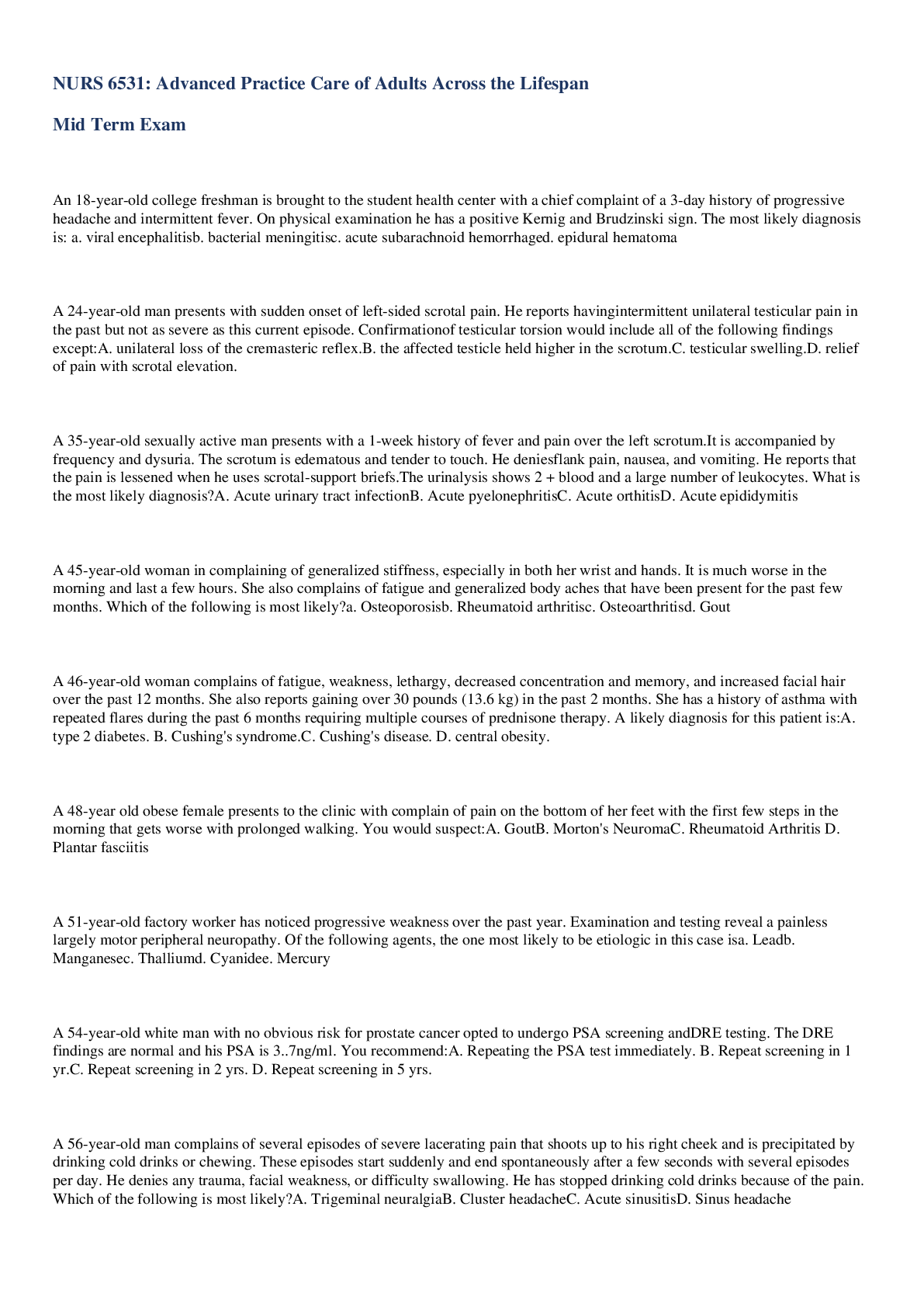
Reviews( 0 )
Document information
Connected school, study & course
About the document
Uploaded On
Nov 10, 2020
Number of pages
13
Written in
Additional information
This document has been written for:
Uploaded
Nov 10, 2020
Downloads
0
Views
94

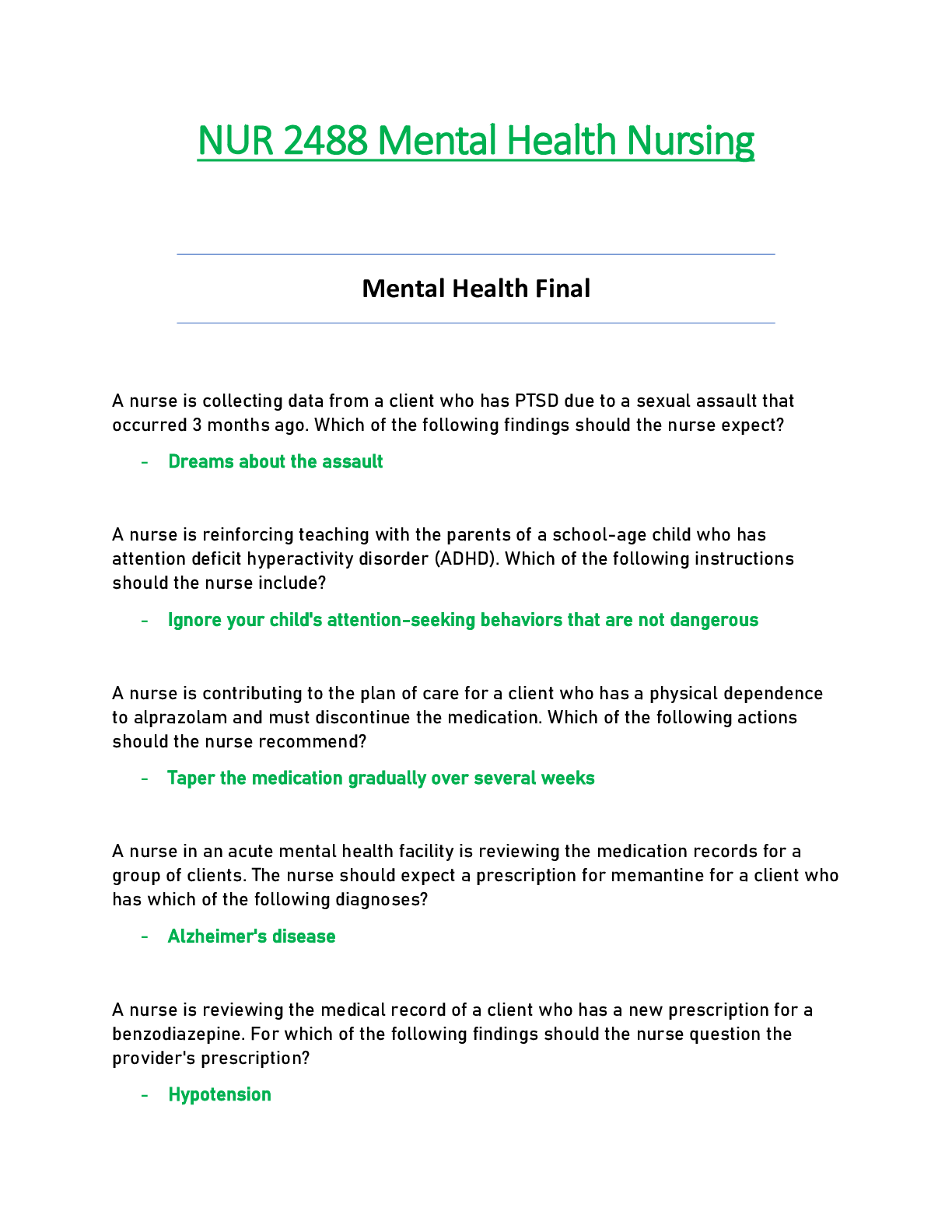
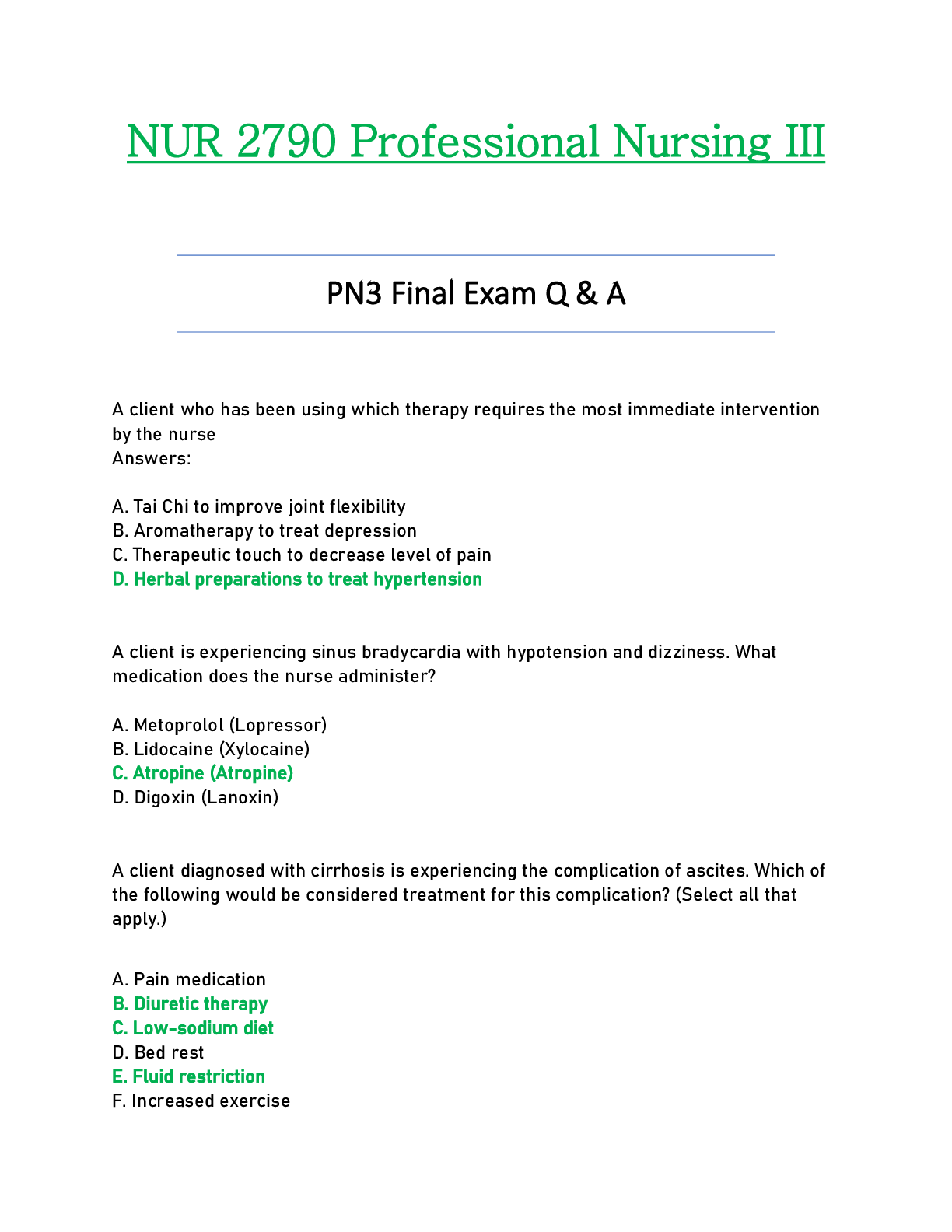
.png)
